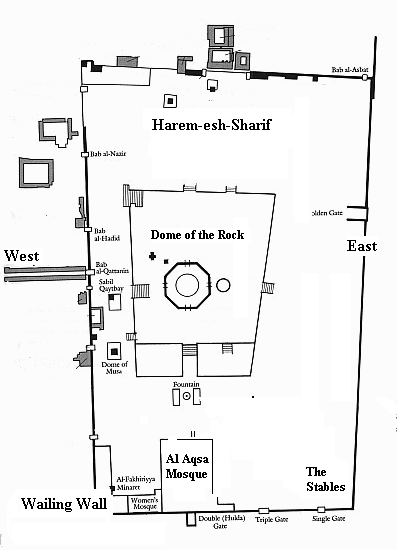
On The Location of the First and
Second Temples in Jerusalem
by Lambert Dolphin and Michael
Kollen
Because of our sins we were exiled from our country and banished from our land. We cannot go up as pilgrims to worship Thee, to perform our duties in Thy chosen house, the great and Holy Temple which was called by Thy name, on account of the hand that was let loose on Thy sanctuary. May it be Thy will, Lord our God and God of our fathers, merciful King, in Thy abundant love again to have mercy on us and on Thy sanctuary; rebuild it speedily and magnify its glory. (The Jewish Prayer Book)

The City of David was never here. It was hidden above, in the Center of Europe.
Under the level pavement at the right of the are vaulted chambers known as "SOLOMON'S STABLES," traditionally said to date from Herod's enlargement of the Mount. To the south is the gray dome of Al Aqsa Mosque. At the lower, left is the Western Wall (the Kotel), the Jewish prayer area. The Dome of the Rock is especially beautiful because of the recent addition of new gold leaf to the anodized aluminum dome. The traditional location of the First and Second Temples lies in the immediate vicinity of the Dome of the Rock. The proposed Northern site for the Temples is to the top left of the Dome. The southern Site for the Temples lies midway between the Dome of the Rock and Al Aqsa mosque, under an Islamic ablution fountain known as El Kas. The level of the bedrock of Mount Moriah outcrops within the Dome of the Rock and is just beneath the paving stones of the surrounding platform. However, to the south the bedrock drops steeply towards the City of David and the junction of Hinnom and Kidron Valleys. (continued)...
(As with many of the other chapters in this History of the Tree of Life, we have taken contemporary articles and essays from magazines and books, from newspapers and the internet, and have added our own commentary between the lines and the paragraphs. We have begun here with two essays by Lambert Dolphin and Michael Kollen):
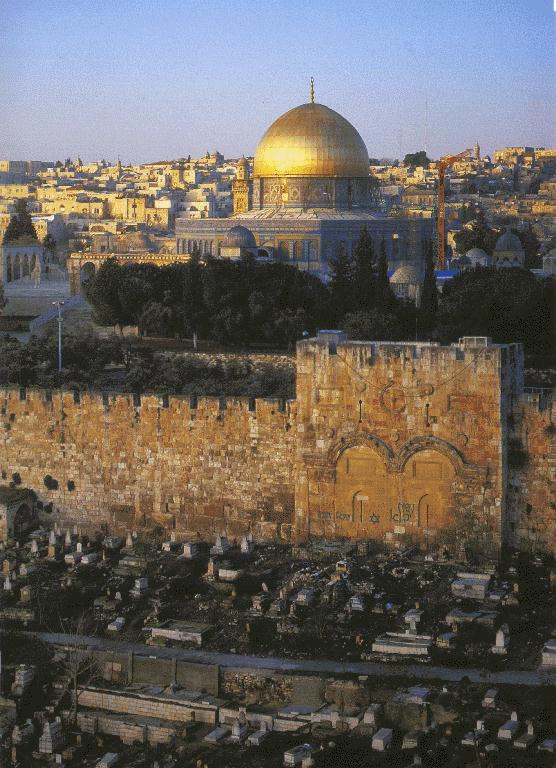
The Eastern (Golden) Gate. The gate is metaphorically shut because The Sun of Righteousness already passed through here two thousand years ago on his way to the Western ends of the earth and the fulness of time...(Matthew 21:18-21; 24:32-34)
We make the assumption here that the reader has already encountered the great Dragon (the Leviathan), and has read at least some of the pertinent chapters leading up to this treatise on the Temple Mount, and therefore that they are already familiar with our Kabbalistic interpretation of history, which holds that immediately after the time of Moses the mind of Israel left this land and followed the spirit of Jehoshua back up into Europe, and back to that place that was hidden all these centuries from the eyes of the world, there at the center of the Universal Oracle, at the place named Beauty on the Tree of Life. (It is an epic story--a script which could only have been written in heaven--which foreshadowed in literary types and divine images, those things that would comet to pass a second time, and which have been unfolding in the earth over the last two thousand years). And thus, that this exile from Jerusalem occurred centuries before the time of Christianity, when Ephraim went backwards the first time. (Open the Book of Hosea the prophet). The warriors of Ephraim rejected Judah and the City of David in those ancient times and, following historical forces away from the center of Israel's own mysteries, returned to that land beyond the Hellespont, and eventually pushed their way back to that city in the East (in Egypt)--the city that Moses built a thousand years earlier as an image, and a replica in stone-below, of the Great City that God would build over time in the worlds above.
Daniel, chapter 9.

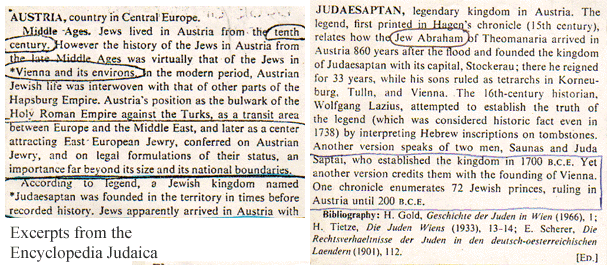
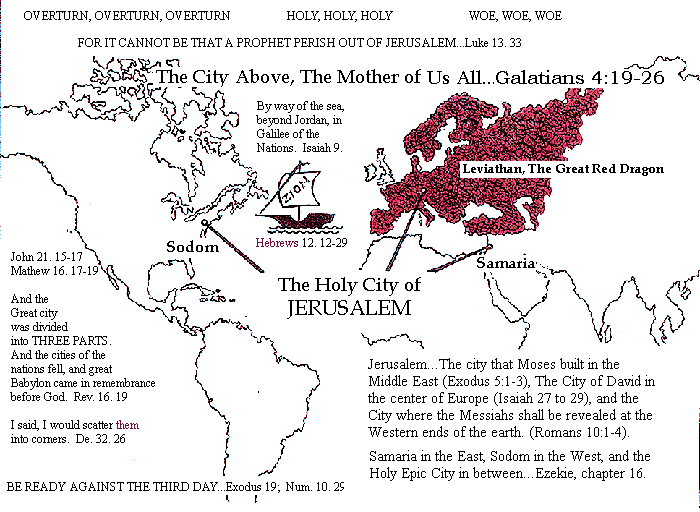
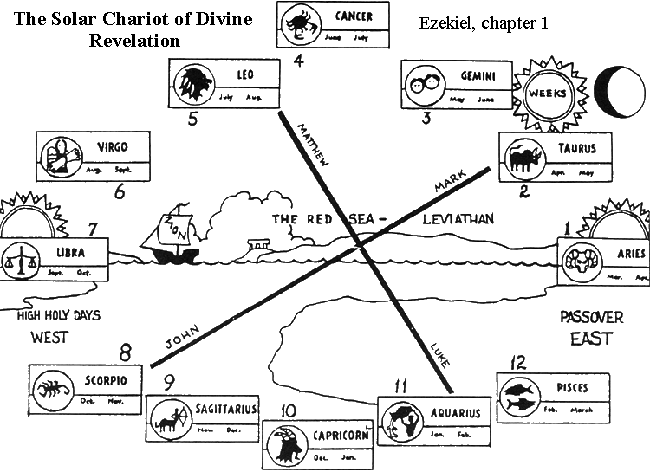
Malachi, chapter 4; Hebrews, chapter 12.
Thus saith the Lord, the heaven is my throne, and the earth is my footstool: WHERE IS THE HOUSE THAT YE BUILD UNTO ME? AND WHERE IS THE PLACE OF MY REST?...(Isaiah 66).
And Solomon had horses brought out of Egypt, and linen yarn (for the garments of the righteous): the king's merchants received the linen yarn at a price.
And they fetched up, AND BROUGHT FORTH OUT OF EGYPT A CHARIOT ( a great Solar Chariot) for Six hundred shekels of silver, and an Horse for an Hundred and Fifty: and so brought they out Horses for all the kings of the Hittites, and for the kings of Syria by their means...(2 Chronicles 1:16,17).
That city in the East is also the place from which the Prophet Muhammad took his his fabled Night Flight through the Seven heavens to the Farthest Mosque--also situated at the Western ends of the earth.
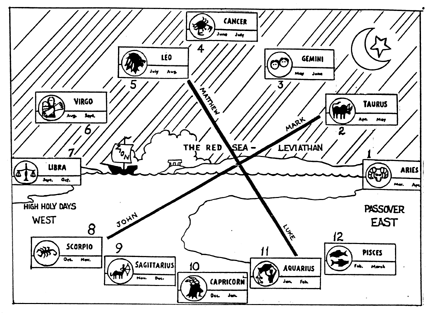
It was a Night Journey
Glory to God who did take His servant for a Journey by Night from the Sacred Mosque (from Harim al Sharif in Jerusalem) to the Farthest Mosque;
Whose precincts We did bless--in order that we might show him some of our Signs: For He (Allah) is the One who Heareth and Seeth all.
We gave Moses the Book and made it a guide to the Children of Israel (Commanding them): Take not other than me as a Disposer of your affairs.
O you who are sprung from those whom We carried in the Ark with Noah! He was a devotee most grateful.
And We gave clear warning to the Children of Israel in the Book, that Twice would they do mischief in the earth and be elated with mighty arrogance (and Twice they would be punished) (See Isaiah 40:1,2)...(Sura 17.1-4).
__________
Say: I seek refuge with the Lord of the Dawn,
From the mischief of created things;
From the mischief of Darkness as it overspreads...(Sura 113.1-3).
__________
And obey God and the Apostle that ye may obtain mercy. Be quick in the race for forgiveness, And for a Garden whose width is that of (the whole of) the heavens and the earth prepared for the righteous...(Sura 3.132-133).
The Temple Mount: Site of the Ancient Jewish Temples
The Temple Mount in the Old City of Jerusalem measures today approximately 45 acres in extent. It is surrounded by a trapezoidal wall: The south wall measures about 910 feet, the North about 1025, the east wall about 1520 and the west wall about 1580 feet in length. The average height above sea level on the platform is about 2400 feet above sea level. Most of the buildings and surface features are Islamic - NO VISIBLE TRACE OF THE FIRST OR SECOND TEMPLES CAN BE FOUND ON THE PLATFORM TODAY. (For the very simple reason that they were never there to begin with).The area is park-like in its settings with plants of trees and shrubs and many ancient buildings and monuments added over the past 1300 years of Moslem stewardship of the site.
The present-day platform area of the Temple Mount lies topographically just below the peak of a Jerusalem ridge system known as Mount Moriah. This is the site David purchased from a Jebusite named Ornan late in his reign. King David prepared the area in order build a permanent House of God to replace the Tabernacle of Moses ...WHICH ACCOMPANIED THE JEWS AFTER THEIR EXODUS FROM EGYPT TO THE PROMISED LAND...
That land in the Middle east is not the Promised Land. It is, however, that place in the world to which the spirit of Elijah descended, from the higher Mount Carmel centuries later, to say:
Thus saith the Lord, HAST THOU KILLED, AND ALSO TAKEN POSSESSION?....(1 Kings 21:17-29).
...David had the plans drawn up for a building whose dimensions were twice those of the Tabernacle, and he amassed great quantities of building materials: stone, cedar, and much gold and silver. However, IT WAS SOLOMON HIS SON WHO ACTUALLY BUILT THE FIRST JEWISH TEMPLE (1 Chronicles 22:14-15, 28:11-20).
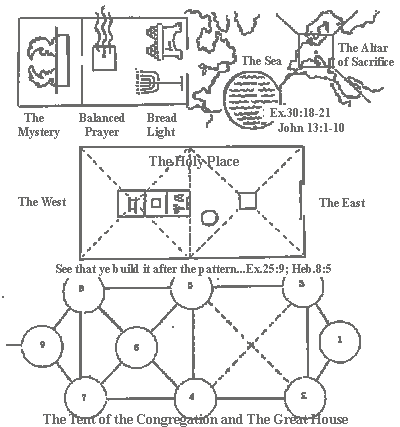
This is Solomon's Temple...Matthew, chapter 24 (KJV)
The ridge system where the Temple Mount is now located is believed by many reputable sources to be the site where Abraham was told to sacrifice Isaac (Genesis 22:1-2). While Solomon built the First Temple about 3000 years ago, Abraham's visit to Mt. Moriah was about a thousand years earlier.
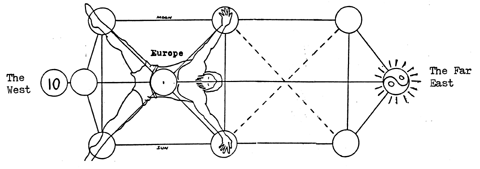
And Abraham saw the place afar off...
For we know that if our earthly house of this tabernacle (our own bodies) were dissolved, we have a building of God, an house not made with hands, eternal in the heavens...(2 Corinthians 5:1).
Consecrated Ground
According to Rabbinical sources both the First and Second Temples were built on the same foundations, at the same location somewhere on the Temple Mount. The site had to be consecrated ground THAT HAD NOT BEEN PREVIOUSLY USED FOR TOMBS and that was not a previous pagan worship site ("high place"). The innermost sanctuary of the Temple, the Holy of Holies, or Kodesh Hakodeshim, where the Ark of the Covenant was placed, MARKED THE EXACT CENTER OF THE WORLD, and was the innermost zone in holiness or sanctity in Jewish thought. The manifest presence of God, the Shekinah, was centered between the cherubim of the Ark and especially noted at the dedication of the First Temple---
When Solomon had ended his prayer, fire came down from heaven and consumed the burnt offering and the sacrifices, AND THE GLORY OF THE LORD FILLED THE TEMPLE. And the priests could not enter the house of the LORD, because the glory of the LORD filled the LORD's house. When all the children of Israel saw the fire come down and the glory of the LORD upon the temple, they bowed down with their faces to the earth on the pavement, and worshiped and gave thanks to the LORD, saying, "For he is good, for his steadfast love endures for ever." (2 Chronicles 7:1-3)
Moving outwards from the Holy of Holies one came to The Holy Place, and then to the Courts of the priests, and of the women and of the Jewish people, then the Court of the Gentiles, and so on, out into the world in decreasing degrees of holiness....
Both ancient Jewish Temples are of interest to Christians as well as to Jews. The Second Temple was modest in size and furnishing until Herod the Great began his grand remodeling plans which continued for 40 years. It was in this enlarged and expanded Second Jewish Temple and its grand courts where the naming and circumcision of Jesus took place (Luke 2:21-39). Later, Jesus astonished the religious leaders with his understanding and insight as a twelve-year-old boy (Luke 2:41-50). On two separate occasions Jesus entered and cleansed the temple by throwing out the money changers and commercial vendors from the courts. (John 2:12-25; Matthew 21:23-26)
In one of his final discussions with his disciples (Matthew 24), Jesus predicted the destruction of the Second Temple. It was in fact leveled to the ground on the 9th day of the month of Av in 70 C.E. The temple was thoroughly razed and the site has been so extensively modified during the late Roman, Moslem and Crusader eras THAT CONSIDERABLE DOUBT EXISTS AS TO WHERE THE TEMPLES ACTUALLY STOOD. (Exactly)!
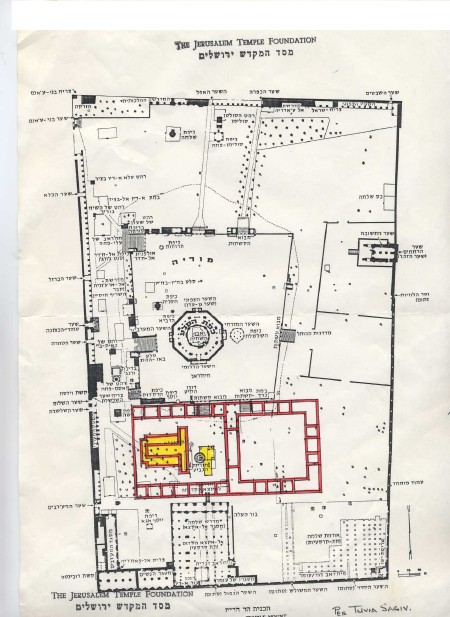
Map of the Temple Mount Today. Where did the Temple stand? (It's a
mystery)
Among the numerous controversies about the Temple is the precise location of the original. There are three primary conjectures under active discussion in recent years. These three areas of interest on the Temple Mount have been the focus of intense investigation, much debate and discussion, and growing controversy. Behind many of these discussions lie serious plans by a number of Orthodox Jewish groups for the building of a Third Jewish Temple on the site when political conditions will permit this.
The primary areas on the Temple Mount
which are seriously discussed in regard to the actual location of the First
and Second Jewish Temples are: The present site of the Dome of the Rock. This
is the so-called "traditional location." There are two variations on this model.
North of the Dome of the Rock. Physicist Asher Kaufman proposed the Northern
location about two decades ago. South of the Dome of the Rock. Tuvia Sagiv,
a Tel Aviv architect, has proposed a Southern location for the Temples with
extensive documentation and research during the past five years.
The Traditional Site
The traditional site of the Temple is said to lie beneath or very near to the Moslem shrine known as the Dome of the Rock. Certain historical accounts say that this building was built by the Moslems to overlay the location of the original Jewish Temple(s) and most rabbis in Israel today associate the original Temple location with this site. Dr. Leen Ritmeyer has researched and written on the original 500 cubit square boundaries of the original Temple Mount site based on this assumption. Recent journal articles still support this view. (1) Former Jerusalem District archaeologist Dr. Dan Bahat vigorously defends the traditional location - drawing on his years of experience and study of the entire city and its history. His lectures on the subject are thorough, convincing and captivating. However, so also are the alternative theories currently proposed!
Traditional Site of the Temples: The
Northern Conjecture
Based on a number of topological and archeological considerations, research by Dr. Asher Kaufman over the past two decades has resulted in serious consideration being given to a site 330 feet to the north of the Dome of the Rock. The Mt. Moriah bedrock outcrops within the Dome of Rock, as is well known. Although the bedrock elevation drops sharply to the south in the direction of the City of David, the level of the bedrock is just beneath the paving stones for over 100 meters to the North of the Dome of the Rock shrine. One particular level outcropping of this bedrock lies under a small Islamic shrine known as "The Dome of the Tablets" or "The Dome of the Spirits," to the Arabs. Both names suggest an association with the Jewish Temples. It is under this small, unimpressive canopy supported by pillars that Dr. Kaufman locates the Temple site. (2)
The Southern Conjecture
Many people who have been following these developments may not yet be aware of a third view, which might well be called "the Southern Conjecture." Since this model is less well known, it will be more fully described here and on these web pages. This view has been championed in the past five years by Tuvia Sagiv, a prominent Israeli architect. There are a number of problems with each of the previously mentioned locations. To fully appreciate some of the difficulties, it is necessary to visualize the topography of the Temple Mount area.
North is at the top of the map. The Mount of Olives is on the far right, Mount Zion on the left. Mount Moriah rises as a long ridge at the south end of the City of David and continues on past the present Temple Mount, and reaches its highest point outside the Northern walls of the Old City, at the top of the map. The bedrock rises when going northward from the base of the City of David to highest ground north of the Temple Mount area. (This is obscured on site since the Temple Mount Platform itself is a large flat area surrounded by retaining wall.) The southern end of the Platform is actually built up on tall underground pillars and arches.
To the east of the Temple Mount lies the Kidron Valley, and the Mount of Olives. To the south, the City of David and the Hinnom Valley. To the west, the famed Western Wall (called in earlier times the "Wailing Wall"). To the north of the Temple site was the Roman military Antonia Fortress, and then, further, the high ground outside the city walls, WHICH MANY BELIEVE was the site of Golgotha. The bedrock of Mt. Moriah continues to rise to the north - outcroppings in the Northern wall reveal road cuts that have been made in the bedrock at the North end of the Old City outside the Damascus Gate and along the main road to the east. The crest of Mt. Moriah is just above the present Garden Tomb.
Critical Issues in Locating the Temple Site: When one compiles all the known factors into a three-dimensional computer model of the Temple Mount area, several problems emerge:
1. Where was the Antonia Fortress? Ancient Jerusalem was protected on the east, south, and west by valleys. The Antonia Fortress was located to the north to protect the weaker north side of the city. (In fact, it was from the north that Titus Vespasian breached the walls in his famous attack in 70 C.E.)
According to ancient sources, the fortress was on a hill about 25 meters high. The current El Omriah school building is on a rock only 5 meters high. From many stratographic and other considerations it is doubted by some experts that his was the actual location of the Antonia Fortress. Tuvia Sagiv's papers discuss the critical issue of the actual location of the Fortress Antonia, which he believes was well to the south, perhaps at the location of the Dome of the Rock.
2. The Location of the Ancient North Moat (the Fosse). Traditional renderings show a deep, filled-in fosse (moat), north of the Temple Mount, lying south of the Antonia Fortress, between the fortress and the Temple Mount. According to ancient sources, however, the Antonia Fortress and the Temple Mount were adjacent to each other. The moat should be to the north of the Tower for protection, placing the Antonia about where the Dome of the Rock stands today! Asher Kaufman's location of the Temples places the moat immediately to the North of the spot where the Temples stood. In fact, Dan Bahat jokes that Kaufman's temple would "fall into the moat!"
3. The Hulda Gates: The Hulda Gates were the primary access to the Temple area from the south. According to the Mishna, the difference in heights between the Hulda Gates and the Holy of the Holies was approximately 10 meters, with about 39 m between the entrance to the Temple mount and the level of the Temple itself. The traditional Dome of the Rock proposals require 20 meters and 80 m separations. The current assumptions regarding Hulda Gate tunnels are not mentioned in the ancient sources. The discrepancies suggest a lower, and therefore, more southerly, location. Tuvia Sagiv in his essays discusses the problem of the Southern Gates and their elevation with respect to the Temples.
4. The View from the North: Josephus Flavius (an eventual adept of the Christian mysteries) describes the fact that the Bizita Hill (Golgotha?) WAS LOCATED NORTH OF THE TEMPLE MOUNT AND OBSCURED THE VIEW OF THE TEMPLE FROM THE NORTH. If the Temple stood at the Dome of the Rock, it would be visible from as far away as the town of Ramallah. In order to obscure the view from the north, it would have to be at a lower level, that is, to the south.
5. King Herod Agrippa's View of the Temple from the West: Josephus, in The Jewish Wars, describes the fact that King Herod Agrippa could look out from his Hasmonean Palace (at or near the present Citadel at the Jaffa Gate), and view the sacrifices at the Azarah, at the altar of the Second Temple. This incensed the Jews, who then built a wall extending the height of the western rear wall of the Temple proper in order to block the view. Roman soldiers, patrolling the western threshold - thus unable to view the Azarah - demanded that the wall be demolished. The Jews objected, and even obtained the consent of Emperor Nero to leave the wall in place.
If the Temple were at the location of the Dome of the Rock, it would have required a Palace tower height of 75 meters to view into the Azarah. THERE NEVER WAS A BUILDING OF SUCH A HEIGHT IN JERUSALEM. This all implies a lower, more southern location of the Temple.
6. The Jerusalem Water Aqueduct from the Judean Hills: The water canals that supplied Jerusalem began in the area of the Hebron mountains, passed through the Solomon's Pools near Bethlehem, and flowed to Jerusalem. The lowest canal reached the Temple Mount through the Jewish Quarter and the Wilson Bridge. According to the ancient authorities, the water conduit supplied water to the High Priests' mikveh (ritual bath) located above the Water Gate, and it also supplied water for the rinsing of the blood off the Azarah. Portions of this aqueduct are plainly visible to this day.
"LIVING WATER," THAT IS, FRESH FLOWING WATER, not water from a cistern, was required for the ritual bath (mikveh) used by the temple priests, and for the washings of the temple in connection with the sacrifices. A survey of the level of the aqueduct reveals that if the Temple had been located at the same elevation as the present Dome of the Rock shrine, the aqueduct would be over 20 meters too low to serve either the Azarah or the Water Gate. From this survey, it appears that the Temple must have been 20 meters lower, and, thus, to the south.
7. Electronic Measurements : Preliminary ground penetrating radar probes by Tuvia Sagiv, while not conclusive, suggest vaults, perhaps "kippim" (rabbinical arches), and other structures which one would expect below the Temple, to the south. The northern sites are virtually solid rock. More recently Sagiv has conducted thermal-infrared scanning of the walls and the platform. During the day the sun heats the Temple Mount uniformly, but at night the cooling (by conduction and radiation) is not uniform, thus revealing subsurface anomalies. In the images shown below, "hotter" areas are bright indicating massive foundations beneath the paving stones. The radar and IR research is discussed in Sagiv's third paper, Penetrating Insights Into the Temple Mount.
Nighttime Thermal Infrared Imagery of the Dome of the Rock: These black-and-white images taken from the original false-color IR scanner images clearly reveal a pentagonal ancient foundation under the Dome. These results are discussed by Tuvia Sagiv in his papers.
8. Research into Later Roman Temple Architecture: After the Bar Kochba revolt in 132 C.E., the Romans leveled the entire city of Jerusalem and a built a Roman city, Aelia Capitolina, on the ruins. To obliterate any Jewish presence on the Temple Mount, they built a temple to Jupiter on the site. A similar temple, built by the same builder at about the same time, has been discovered at Baalbek, Lebanon.
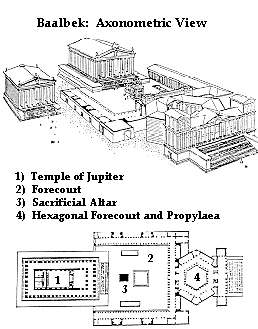
The Roman Temple at Baalbek, Lebanon
The Roman architectural practices of the time featured a rectangular basilica, and a polygon structure opposite a courtyard. When this architecture is overlaid on the Temple Mount, it matches the Al Aqsa Mosque and the Dome of the Rock exactly This unique architectural similarity suggests that the Roman Temple to Jupiter may have been on this very site, converted for Christian purposes in the 4th Century, and then served as the foundation for the present Moslem structures, the Al Aqsa Mosque and the Dome of the Rock, which were built in the 7th Century.
Jerome's commentary on Isaiah mentions an equestrian statue of the Emperor Hadrian being placed directly over the site of the Holy of the Holies. If the Baalbek architecture is the correct model, this would place the Holy of the Holies somewhere beneath the present El Kas foundation. When a map of the Baalbek Temple is overlaid on the present structures of the Temple Mount a striking similarity can be seen:
Which Conjecture is Correct?
In Israel it is often said that if you have two Jews you will have three opinions! Only time will tell which of the above views is correct. These conjectures will continue to be debated until Israel is able to conduct a thorough archaeological investigation beneath the Temple Mount itself. Unfortunately, the Temple Mount presently remains under the supervision of the Waqf, the Supreme Moslem Council, and they have prevented any systematic archeological studies. In fact, the Waqf has gotten increasingly resistive to investigations of any kind on the Platform - which they consider to be a huge outdoor mosque sacred to Islam.
Who knows what events developing in the history of Jerusalem will one day change the status quo, allowing scientific investigation of the entire Temple Mount, below ground as well as above? Then, according to the hopes and dreams of devout Jews for centuries, a Third Temple can be built on the foundations of the First and Second Temples and temple worship according to the Torah restored.
Lambert Dolphin's Web Pages: (http://ldolphin.org/)
Arab Leaders Deny Jewish History on The Temple Mount
Posted: August 06, 2003
The recent statements of Palestinian leaders warning of "grave consequences" of the "provocative" decision by Israel to allow Jews to visit the Temple Mount are only the latest in a history of attempts by Arab leaders to minimize or deny the historical connection between Jews and the Temple Mount. Arab newspapers and speakers consistently refer to Jewish connections to the Temple Mount as "alleged."
HISTORY
The Temple Mount, which Arabs refer to as the Haram al-Sharif and on which today the Al-Aqsa Mosque is located, is the site on which the biblical King Solomon erected his Temple nearly 1000 years before the Common Era (see I Kings 5:15-7:51). This First Temple was destroyed by the armies of the Babylonian King Nebuchadnezzar in the sixth century BCE, and was replaced by a Second Temple some seventy years later. The Second Temple was destroyed in the year 70 C.E. by Roman armies, whose victory was immortalized in the Arch of Titus that may be seen in Rome to this day. Jews have venerated the site of the two Temples and have made pilgrimages there for two thousand years. According to some rabbis, Jewish law prohibits Jews from entering the Temple Mount before undergoing rituals of purification that are not currently practiced; partly as a result of this prohibition, Jews for millennia have prayed at the Western Wall of the Temple Mount, outside the Mount proper.
"For 34 years [the Israelis] have dug tunnels [around the Temple Mount]…they found not a single stone proving that the Temple of Solomon was there, because historically the Temple was not in Palestine [at all]. They found only remnants of a shrine of the Roman Herod… They are now trying to put in place a number of stones so that they can say 'We were here.' This is nonsense. I challenge them to bring a single stone from the Temple of Solomon."
Yasser Arafat
Al-Hayat (London), October 5, 2002
[Trans. MEMRI and BBC Worldwide Monitoring]"The claims being made by the rulers of Israel and its rabbis about the alleged Temple are pure fabrications without any base or foundation."
Statement by the Higher Islamic Authority of Palestine
Al-Quds (PA), December 28, 2001
[Trans. BBC Worldwide Monitoring]Sabri: There is not [even] the smallest indication of the existence of a Jewish Temple on this place in the past. In the whole city, there is not even a single stone indicating Jewish history. Our right, on the other hand, is very clear. This place belongs to us for 1500 years. Even when it was conquered by the Crusaders, it remained Al-Aqsa, and we got it back soon afterwards. The Jews do not even know exactly where their Temple stood. Therefore, we do not accept that they have any rights, underneath the surface or above it.
Die Welt: It is agreed among archeologists that the Wailing-Wall is part of the foundation of Herod's temple. The Bible and other antique sources report about this place in detail. Why can't you respect the Jewish connection to this place?
Sabri: It is the art of the Jews to deceive the world. But they can't do it to us. There is not a single stone in the Wailing-Wall relating to Jewish History. The Jews cannot legitimately claim this wall, neither religiously nor historically. The Committee of the League of Nations recommended in 1930, to allow the Jews to pray there, in order to keep them quiet. But by no means did it acknowledge that the wall belongs to them.
Die Welt: Why don't you allow Israeli scientists to dig there to look for possible remnants and proofs for or against the existence of the Jewish temple?
Sabri: We categorically reject all excavations under the Al-Aqsa mosque, because they would endanger the historical buildings on the site. Besides, they have already dug everywhere. All they could find were remnants of buildings from the Omayyad-period. Everything they excavated was related to Arabs and Muslims.
Sheikh `Ikrima Sabri
PA-appointed Mufti of Jerusalem
Interviewed by German magazine Die Welt, January17, 2001
[Trans. MEMRI]"As is known, the Jews have no religious shrines in the Palestinian territories, especially in Jerusalem, except this claim for which there is no religious or historical proof -- the claim that the Temple of Solomon or its ruins are buried under the foundations of the blessed Al-Aqsa mosque!"
Al-Jazirah (Saudi Arabia) editorial
December 29, 2000
[Trans. BBC Worldwide Monitoring]"President Arafat said that no one can impose anything on us with regard to Jerusalem. He pointed out that there are attempts to usurp parts of Jerusalem, like the Armenian neighborhood. He added: I cannot accept that. I cannot betray the Armenians' property and churches, because these are integral parts of holy Jerusalem. He reiterated that the Wailing Wall [the Western Wall], as they call it, is Al-Buraq Wall which is an Islamic waqf religious endowment since the issuance of Umar's Covenant. He noted that it was the Shore phonetic Committee which allowed the Jews to pray in that place. He said that Al-Buraq Wall is the property of Islamic Awqaf. He added that even chief rabbis prevented prayers there, because it was not proven yet that the temple is located there."
Voice of Palestine (Ramallah)
September 3, 2000
[Trans. BBC Worldwide Monitoring]"[The Israelis] claim that 2000 years ago they had a Temple [on the Temple Mount]. I challenge the claim that this is so. But even if it is so, we do not accept [current Israeli claims on the Temple Mount]."
Mahmoud Abbas (Abu Mazen)
Kul Al-Arab (Israel), August 25, 2000
[Trans. MEMRI]"No stone of the Al-Buraq wall [the Western Wall] has any relation to Judaism. The Jews began praying at this wall only in the nineteenth century, when they began to develop [national] aspirations…"
Sheikh `Ikrima Sabri
PA-appointed Mufti of Jerusalem
Kul Al-Arab (Israel), August 18, 2000
[Trans. MEMRI]"[The Israelis] are insisting on sovereignty over the Al-Aqsa mosque on the pretext that an Israeli Temple is buried beneath it and that, through their continued sovereignty, they can one day unearth it…Their claim was not substantiated by the excavations they carried out around and under the mosque. However, they insisted on their demand to pray in the courtyard of the mosque."
Nabil Sha'ath
PA Minister of Planning and International Cooperation
Voice of Palestine (PA), July 26, 2000
[Trans. BBC Worldwide Monitoring]"[Sheikh Yusuf Salamah, Undersecretary of the PA Awqaf and Religious Affairs Ministry] warned of the dangerous excavations which the Israeli Antiquities Department is carrying out under the [Al-Aqsa] mosque [on the Temple Mount]. He underscored that the holy city is Arab and Islamic and pointed out the failure of all Israeli attempts and claims with regard to the existence of the Temple."
Al-Quds (PA), July 15, 2000
[Trans. BBC Worldwide Monitoring]"As to what has been happening inside the Holy City, not only the Moroccan quarter has been seized and demolished, Your Majesty, as the two of us discussed previously, to widen the so-called Wailing Wall [the Western Wall]. To do this, the tombs of the Moroccan Muslim Imams would be affected. They removed them. Not only this, but [the Israelis] have also been trying to take over houses, shops, lanes and streets, either under the pretext of exploration or, as they recently did by closing the major gates of the mosque to conduct the so-called exploration operation of what they called the remains of the Solomon Temple when all the historical evidence, Your Majesty, proved that it was not there at all in another place far away from this spot. This is what historians had been saying."
Yasser Arafat
Addressing the "Jerusalem Committee" in Marrakesh, Morocco
January 25, 1992
[Trans. BBC Worldwide Monitoring]
© 2003 Anti-Defamation League
(Please hit "Refresh" if all of the following images and articles do not appear on the first download...Thank you)
VISITING THE TEMPLE MOUNT
by Lambert Dolphin
Walk about Zion, go round about her, number her towers, consider
well her ramparts,
go through her citadels; that you may tell the next generation that this is
God,
our God for ever and ever. He will be our guide for ever. (Psalm 48:12-14).
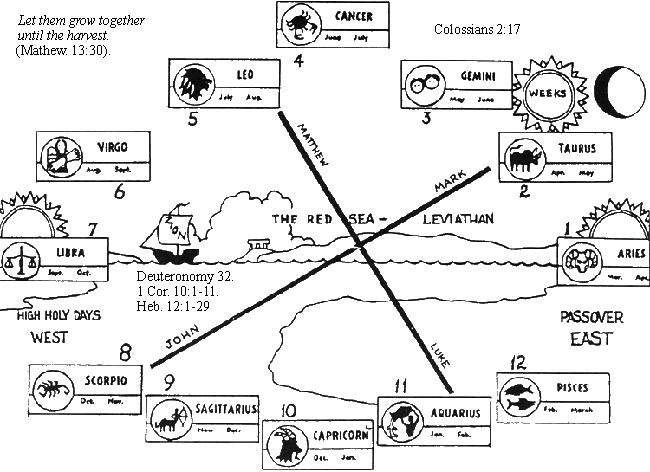
For from the Rising of the Sun even unto the going down of the same My Name shall be great among the Gentiles; and in every place incense shall be offered unto My Name, and a pure offering for My Name shall be great among the people, saith the Lord...(Malachi 1:11).
The Old City and the Temple Mount
Today a visitor can enter the Old City of Jerusalem by one OF SEVEN GATES. Some gates were named by location. The Jaffa Gate faces West towards Tel Aviv and Joppa. The Damascus Gate is in the North wall where a traveler would enter if he had come from Galilee, the Golan Heights and Damascus. The Zion Gate is, logically, on Mt. Zion near the traditional Tomb of David and site of the Upper Room of the Last Supper. The Dung Gate faces South towards the Hinnom Valley where refuse from the city was dumped in former times into the Hinnom Valley. The Sheep Gate--or, ST. STEPHEN'S GATE (go to Der Judaenplatz in Vienna), or Lion's Gate--is next to the sheep market, and so on.
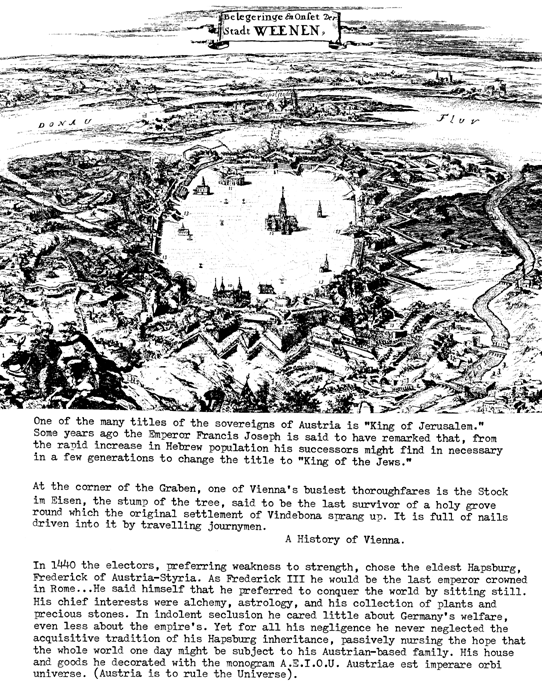
Open the Book of The Acts of the Apostles here in Vienna (old Vindebona).
The present walls around the Old City were built from 1537 to 1541 by Sultan Suleiman the Magnificent after the Ottoman conquest of Israel. At that time most of the ancient walls were reduced to rubble. Suleiman ordered that Jerusalem be fortified to protect its people against marauding Bedouins. The walls were rebuilt upon the foundations of the walls constructed during the time of the Second Temple and the later Roman expansion. For the most part, the modern gates of the city are not closely related to the walls and gates that existence in Roman times or earlier. There is some debate about the correct location of some of the ancient gates and walls. However visitors to the recently restored Jewish Quarter in the Old City can see an uncovered section of the wall built by Nehemiah at the time of the return from the Babylonian exile.
The Old City retains its charm and fascination to this days. Narrow crowded shops and the Oriental bazaar with its many markets offer endless adventure for visitors and pilgrims. It is hard to escape the feeling that one has stepped in the timeless, changeless past. Each quarter of the Old City brings an immediate shift in architecture and shops, in passers-by and inhabitants alike.
The Temple Mount is conspicuous whether viewed from the Mount of Olives, or from the Lutheran church tower across from the Holy Sepulchre, or from the Citadel Museum roof. Normally tranquil and peaceful with its park like setting, one would hardly guess that this small parcel of land - less than 50 acres - is the center of the world and the hottest piece of real estate anywhere on earth. BIBLICALLY SPEAKING, IT'S MOST EXCITING HISTORY LIES YET AHEAD.
The Golden Gate
The Golden Gate is the most important and most impressive gate in Jerusalem,
and the only visible entrance to the city of Jerusalem from the East. This oldest
of all the gates to the city was the only one not rebuilt by Suleiman the Magnificent
in AD 1539-42. Monolithic stones in the wall just above ground have been identified
as 6th Century BC masonry from the time of Nehemiah, (Biblical Archaeological
Review [BAR], Mar/Apr 1992, p40). The
Golden Gate was walled up by the Arabs in the year 810. It has remained closed
now for nearly 12 centuries.
The Muslim name of the gate is Bab al-Dhahabi. It is a now-closed double gate. The North portal is known as Bab al-Tawba, the Gate of Repentance, and the Southern Portal, Bab al-Rahma, the Gate of Mercy. The ancient Eastern gate to Jerusalem could be the one mentioned as THE "BEAUTIFUL GATE" in Acts 3:2,10. The term Golden Gate may have been derived from the Latin Vulgate version of the Bible...
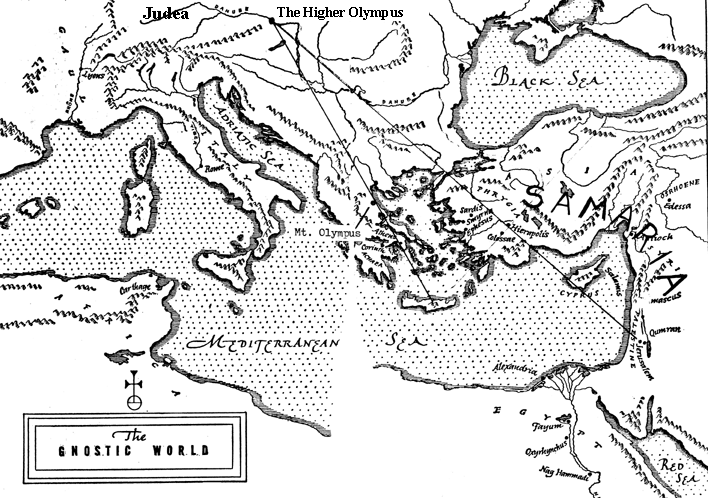
Great is the Lord, and greatly to be praised in the City of our God, in the mountain of His holiness.
BEAUTIFUL FOR SITUATION, the joy of the whole earth, is Mount Zion, on the sides of the North, THE CITY OF THE GREAT KING...(Psalm 48L1,2).
If one strikes a line from Athens through Mt. Olympus in Thessaly they will arrive again at that place in the center of Europe, at the Navel of the Earth, and the place named Beauty on the Tree of Life. It is that place in the Mind of Reality itself which literally separates Jerusalem from Athens. Or to put it another way: the mind of the higher Israel from the mind of Egypt. (Exodus, chapter 19 is a prophetic description of the events that emanated into the world from this place in the center of Europe in the 20th century).
"In the earliest Greek New Testament, the word for 'beautiful' is oraia. When Jerome translated the New Testament into Latin in the 4th Century he changed the Greek oraia into the similar sounding Latin aurea, rather than to the Latin word for 'beautiful.' So the Latin Vulgate text read 'Golden Gate' instead of 'Beautiful Gate.'" (BAR, Jan/Feb 1983, p.27) (continued)...
We are also told that when the Romans came up into that place in the center of Europe in the first century B.C. they found a temple on Fraunberg, the Woman's Mountain, in Austria, dedicated to Norea. The translator of the Gnostic text, The Reality of the Rulers, interprets her name Orea from the Greek "Horaia," meaning Beautiful, or Beauty, a variant form of Norea. (The Gnostic Scriptures, by Bentley Layton, p.73):
Thy great name of thine is upon me, O self-begotten perfect One, who is not outside me. I see thee, O thou who art visible to everyone. For who will be able to comprehend thee in another tongue? Now that I have known thee, I have mixed myself with the immutable. I have armed myself with the armour of light. I have become light. Because the Mother was at that place because of the splendid Beauty of grace. Therefore I have stretched out my hands while they were folded. I was shaped in a circle of the riches of the light which is in my bosom...
This is the book which the great Seth wrote, and placed in high mountains on which the sun (the light of common reason) has not risen, nor is it possible. And since the days of the prophets, and the apostles, and the preachers, the name has not risen upon their hearts, nor is it possible. And the ear hath not heard it." The Gospel of the Egyptians 66-68.
__________
It is Norea who cries out to them. They heard, and they received her into her place forever. They gave it to her in the name of the Father of Nous (Fire)...And she began to speak with words of Life, and she remained in the presence of the Exalted One, possessing that which she received before the world came into being. She has the great mind of the Invisible One...
There will be days when she will behold the Pleroma (the All), and she will not be in deficiency, for she has the Four holy helpers who intercede on her behalf with the Father of all Adamas. He it is who is within all the Adams, possessing the thought of Norea who speaks concerning the Two Names (YHVH-Elohim) which create a Single name." The Thought of Norea, The Nag Hammadi Library
...The Golden Gate has long interested many Muslims, most Jews and Christians as the place of the Last Judgment. (And we would say that those judgments are already unfolding at this very time in the Middle East). Historically, judgments were rendered in the gates of the city (Gen. 19:1, 23:10, for instance). Since the Messiah was to come from the East (Matthew 24:27), it was concluded that his judgment would be at the eastern gate. This is one reason for the many Muslim, Christian, and Jewish graves on the Eastern slopes of the Temple Mount, in the Kidron Valley, and on the Western slopes of the Mount of Olives
Some Muslims place Allah's final judgment at this location also. Jews link the Messiah's arrival with this gate and Christians have for centuries associated the Golden Gate with Palm Sunday and also with the Second Advent (Luke 19:35-38). Jews expect the Messiah to come through the Golden Gate, Muslims also expect Jesus to return to our world at the end of the age to participate in the final judgment. Christians believe it will be Jesus Christ who will conduct that final judgment. Zechariah 14:4-5 clearly states that the Messiah of Israel will return to Jerusalem from the summit of the Mount of Olives AND THEN SURELY PROCEED INTO JERUSALEM FROM THE EAST, in the direction of the Golden Gate.
Muslims compare the final judgment of mankind to the crossing of a narrow knife blade which stretches from a mountain (the Mount of Olives is often mentioned in Arab legend) to the "gate of heaven." This knife-edged bridge evidently spans the Kidron Valley - as did an ancient stone bridge in Roman times.
Because of the Messianic association with the Golden Gate - which clearly symbolizes both judgment and mercy because of the Arabic names attached to the gate - adherents to all three faiths have wanted to be buried as close as possible to the Golden Gate. THE ASSUMPTION WAS THAT THE DEAD IN THE IMMEDIATE VICINITY WOULD BE THE FIRST TO BE RAISED. In the Middle Ages the Jews were forbidden to bury on Mount Moriah. Instead they buried their dead opposite the gate and to the South on the Mount of Olives. This Jewish cemetery is the oldest in continuous use anywhere in the world. A burial plot, it is said, if it were available there, could cost $50,000 or more. The Christian cemetery lies in the bottom of the Kidron Valley (in sad condition) while the Muslim burial area covers the eastern Temple Mount hillside up to and surrounding the Golden Gate.
At the end of the First Temple period the eastern gate was closed (see Ezekiel XLIV, I. "Then he brought me back the way of the outer gate of the sanctuary which looketh toward the east; and it was shut.")During the Second Temple period this was the site of the Shushan Gate, mentioned in the Mishnah (Middot 1, 3), or the Eastern Gate (Nehemiah III, 29). A causeway supported by arches ran from the gate across the Kidron Valley, and was known as the Causeway of the Heifer, since the High Priest used this way to reach the Mount of Olives where the ritual burning of the Red Heifer took place, to purify the pilgrims with its ashes (Parah 111, 6; Shekalim IV, 2).
The Mercy Gate, 257 m north of the south-eastern corner of the Temple Mount, is the most beautiful of all the gates of Jerusalem. It is approached from within the Temple Mount BY TWENTY TWO STAIRS, WHICH LEAD INTO A MAGNIFICENT ENTRANCE, decorated with unusually intricate carvings of acanthus leaves, which appear to be moving. The gateroom is a hall with six domes supported by huge marble pillars. On the east side of the hall are two gateways, now blocked up, beautifully decorated on the outside.
(Blame it all on Helena, the mother of Constantine, who was among the first to come to this city with a retinueof priests, saying "This must by this place, and that must be that place." The world has been making pilgrimages to those sites ever since).
The New Testament (Acts IlI 2) calls this the Beautiful Gate; it may therefore BE ASSUMED to have existed during the period of Aelia Capitolina. However, its present beauty was not attained until the reign of Justinian, in honour of the Christian tradition which fixes this as the site of Jesus' entry to the Temple courtyard. The gate was probably open during the Byzantine period, and the Emperor Heraclius entered through it after taking Jerusalem in 629. After the Muslim Conquest, when the Dome of the Rock and the EI-Aksa Mosque were built, it was blocked to prevent unsupervised access to the mosque area.
AI-Muqaddasi (985) mentions two arches to this gate, the southern one called Bab e-Rahma (Gate of Mercy) and the northern one Bab e-Tauba (Gate of Repentance); both were closed. The double gate is also mentioned by Nasir i-Khosrau (1047) and Mujir e-Din (1496). Shams e-Din e-Suyuti, who visited Jerusalem in 1470, ascribes a reference in the Koran (LVII, v3) to this gate: "Then there will separate them a wall wherein is a gate, the inner side whereof containeth mercy, while the outer side thereof is toward the doom." According to this verse the inner gate, containing mercy, is Bab e-Rahma, while the outer one is Bab e-Tauba, indicating the punishment in Gehenna. The Kidron Valley is known in Arabic, among other names, as Wadi Jehennum (Valley of Gehenna) implying punishment and torture. The gate is also known in Arabic as Bab el-Dahariyeh (Gate of Eternity), recalling the visions of Joel (IV, 2 and 12), or the Twin Gate, because of its shape, which can be seen quite clearly from the Mount of Olives. In the time of the Crusaders it was opened twice a year on Christian festivals: once in the spring, on Palm Sunday, recalling Jesus' triumphal entry to the city through this gate (St. Matthew XXI, 1-8); and once in the autumn, to commemorate the entry of the Emperor Heraclius. The gate was finally closed under Turkish rule....
The pillars of the Golden Gate are said to be a gift of the Queen of Sheba to Solomon according to one ancient legend, but these would not be part of the present gate above the surface of the ground which is too recent. Some scholars have noted that the double gates of repentance and mercy contrast not only Law and Grace but are reminders of the two bronze pillars, Jachin, "in his counsel" and Boaz, "by his strength" which stood in the front of the First Temple. James 2:13 notes that God is just, but that his mercy "triumphs" over judgment. According to James, although God is just and must judge the world with equity and impartiality, the mercy of God is a greater and higher attribute of the God of the Bible. He is ready to forgive all who seek him, and his mercy abounds.
Penitents to the Temple entering the courts through the Northern Gate of Repentance in Temple Times could seek the forgiveness of the living God by sacrifice and petition in the Temple, and leave by the Southern Gate having obtained mercy and grace. The Golden Gate is thus a wonderful reminder of the unchanging character of God.
The interior corridors of the Golden Gate are exceptionally beautiful and well-built according to published reports. Sadly, visitors to the Temple Mount today are not allowed to inspect the interior of the Golden Gate. Nor can tourists walk through the Muslim cemetery along the Eastern Wall to inspect the exterior of the gate. One can only hope that this gate can be reopened in the near future and fully restored for access to the Temple site by all nations.
Thus says the LORD: "Keep justice, and do righteousness, for soon my salvation will come, and my deliverance be revealed. Blessed is the man who does this, and the son of man who holds it fast, who keeps the sabbath, not profaning it, and keeps his hand from doing any evil." Let not the foreigner who has joined himself to the LORD say, "The LORD will surely separate me from his people"; and let not the eunuch say, "Behold, I am a dry tree." For thus says the LORD: "To the eunuchs who keep my sabbaths, who choose the things that please me and hold fast my covenant, I will give in my house and within my walls a monument and a name better than sons and daughters; I will give them an everlasting name which shall not be cut off. "And the foreigners who join themselves to the LORD, to minister to him, to love the name of the LORD, and to be his servants, every one who keeps the sabbath, and does not profane it, and holds fast my covenant - these I will bring to my holy mountain, and make them joyful in my house of prayer; their burnt offerings and their sacrifices will be accepted on my altar; for my house shall be called a house of prayer for all peoples. (Isaiah 56:1-7)...
Josephus states (Wars V, 184-189) that the Eastern temple enclosure wall was the only one not rebuilt by Herod the Great. The ancient gate beneath the Golden Gate may therefore date from Solomonic times or at least from the time of Nehemiah. Such a view of consistent with Asher Kaufman's view that the First and Second Temples were located 110 meters North of the Dome of the Rock in the immediate vicinity of the small Dome of the Tablets shrine on the main temple platform.
"Moreover, it now seems clear that before the Golden Gate was constructed, the entrance to the Temple Mount from outside the city was in exactly the same location. Recently, part of an arch was discovered directly beneath the Golden Gate. This partial arch definitely belongs to an older gate, a gate that many date even to Solomonic times." (Asher Kaufman, BAR, March/April 1983, p. 45).
The mid-point of the Golden Gate is 348 feet North of the East-West centerline of the Dome of the Rock allowing a straight-line access into the temple courts from the East assuming Kaufman's theory is correct. Kaufman's model for the location of the First and Second Temples lines up the Temples, the Golden Gate and the Red Heifer Altar on the Mount of Olives. Kaufman's location for the site of the Red Heifer offering is a small walled garden owned by the Armenian Church. It is located just across the summit road from the Muslim Mosque of the Ascension which is a traditional location for the place of the Ascension of Jesus Christ into heaven. Kaufman believes the Red Heifer altar site would have been sanctified ground made holy by a system of underground arches beneath the garden designed to prevent any defilement from dead bodies from seeping upwards to the sanctified ground. There are locked cisterns in the garden which could be explored to test Kaufman's hypothesis. Our scientific team sought to obtain the necessary permission to explore the garden cisterns from the Armenian Patriarch in our science and archaeology work in Israel in 1983, however it was not granted to us at that time.
Ezekiel 43:1-9 supports the Jewish tradition that the entire Temple Mount as well as the Temple itself is set aside in a special way for the service of the Holy One of Israel. God has evidently been, over many centuries, offended by the many defilements of this area. Cemeteries, tombs and burial places as well as idolatrous shrines are clearly inappropriate in the vicinity of the Temple Mount. Apparently these graves must all be removed before a temple acceptable to Yahweh can be built there:
"Afterward he [the Angel of the LORD] brought me [Ezekiel] to the gate, the gate [of the temple] facing east. And behold, the glory of the God of Israel [the Shekinah] came from the east; and the sound of his coming was like the sound of many waters; and the earth shone with his glory. And the vision I saw was like the vision which I had seen when he came to destroy the city, and like the vision which I had seen by the river Chebar; and I fell upon my face. As the glory of the LORD entered the temple by the gate facing east, the Spirit lifted me up, and brought me into the inner court; and behold, the glory of the LORD filled the temple".

The True Golden Gate (Malachi, chapter 4)....follow the course of history, and then open the Book of Ezekiel at the Western end of the earth.
While the man was standing beside me, I heard one speaking to me out of the temple; and he said to me, "Son of man, this is the place of my throne and the place of the soles of my feet, where I will dwell in the midst of the people of Israel for ever. And the house of Israel shall no more defile my holy name, neither they, nor their kings, by their harlotry, and by the dead bodies of their kings, by setting their threshold by my threshold and their doorposts beside my doorposts, with only a wall between me and them. They have defiled my holy name by their abominations which they have committed, so I have consumed them in my anger. Now let them put away their idolatry and the dead bodies of their kings far from me, and I will dwell in their midst for ever."
The Temple Esplanade
The Haram esh-Sharif, or Noble Sanctuary, as the Muslims call the Temple Mount, is a garden plaza containing many varied structures such as paved platforms, domes (qubbeh), prayer niches (mihribs), fountains and arcades (mawwazin). In the course of time the Temple Mount has acquired a large number of fountains (sabil) and small shrines, minarets from the Mamaluk period (manara or maazneh), prayer platforms (mutasalla) Many of these Islamic features were installed as gifts from important visitors caliphs and potentates. Religious schools (madraseh) and various offices may be found around the perimeter. In the compound today there are about one hundred structures, both large and small.
Entering the Mount from the Mograbi Gate the visitor will find an Islamic Museum immediately to the right. The Islamic Museum contains a good collection of Byzantine and Islamic antiquities. Slightly east of the Museum is the cavernous El-Aksa Mosque, a huge rectangular, largely unadorned, structure featuring a small gray dome. This present building dates from the 10th Century when it accepted that Jerusalem was masjid el-aksa, "the furthermost sanctuary." The glacial marble columns, a gift from Mussolini, date from the most recent major restoration of 1938-1942. The first mosque on the site, that of the Caliph Abd el Malek ibn Mirwan, (or his son El-Walid), was built between 709 and 715 AD, but was twice destroyed by earthquakes in the first 60 years of its existence. After the capture of Jerusalem in 1099, the mosque became the first royal residence and then the headquarters of the Knights Templars. Saladin tore down many of the Crusader additions and later Mamluk sultans made additions and changes. An ascending passage from the walled-up double gates in the Southern Wall of the temple compound rises to the surface of the present platform just North of the mosque.
While the Dome of the Rock rests on the bedrock of Mt. Moriah, El-Aksa mosque is supported on pillars, fill, and vaults from below. This makes the building more susceptible to earthquakes of course. Severe earthquake damage occurred in 774, 777, and 1033 according to historic records. The building was built on the foundations of a Byzantine church built during the reign of Justinian and dedicated to the Virgin Mary. Byzantine historian Procopius wrote that the church was built in 560 AD and burned down by the Persians in 614.
The Pinnacle of the Temple where Jesus was tempted by the devil (Matthew 4:1-11) has been traditionally associated with the south-eastern corner of the Temple Mount because of the great height above the Kidron Valley below. The recent discovery on an inscribed stone at the south-west corner indicated that corner was "the place of trumpeting" (blowing of the Shofar) has raised the possibility that the second temptation of Jesus took place there.
Eusebius (Ecclesiastical History, 2:23) tells us that James the Just, brother of Jesus and pastor of the early Christian church in Jerusalem was martyred by being thrown down from the pinnacle of the temple mount. He survived the fall and was then stoned, praying for forgiveness for his persecutors as he died. Stephen, the first martyr of the Christian church (Acts 6:8-7:60) was also martyred near the temple mount ("outside the city"). The gate that bears his name commemorates the traditional area where he finally died...
THE DOME OF ASCENSION (Qubbet el-Mi'Araj), built around 1200, commemorates MOHAMMED'S LEAP INTO THE HEAVENS, or at least the place he has supposed to have prayed before his ascension. It is a copy of a Byzantine Dome on the Mount of Olives that marks the spot of Jesus' Ascension according to Islamic tradition. The existence of this structure, built from Crusader materials, suggests that the Dome of the Rock may not have been the exact spot of Mohammed's alleged ascent into paradise.
A small dome, the Dome of the Prophet (E-Nabi), stands east of the Dome of the Rock and was built by the Turkish governor of Jerusalem, Muhammed Bey in 1538. It houses a well-built mihrab, or prayer niche facing Mecca.
The Dome of the Prophet Elijah (Qubbet el-Khadr) is an open dome at the northwest corner of the platform supported by six marble columns with an interior place for prayer.
The Dome of the Rock is not a true mosque but a shrine. Begun about 688 and finished about 691 (other writers say 692 to 697) - it is the first and oldest Islamic shrine in the world. THIS OCTOGONAL STRUCTURE is one of the most beautiful edifices in the Middle East. The interior contain two concentric rows of pillars - the inner circle supports the dome, and the outer circle the best of the building. The inner circle of pillars, about 60 feet in diameter - encloses exposed bed rock which rises several feet above the floor. THIS IS TRADITIONALLY THE FAMOUS FOUNDATIONS STONE. The dome-supporting pillars are sixteen in number, twelve of marble and four of granite. Sixteen windows in the cupola are made of colored glass against a background of gold. Some of these windows go back to the 15th Century, but most date from the 18th and 19th. The octagonal walls of the building itself contain 56 windows, 7 in each wall. The outer circle of pillars supporting the building consists of eight of marble and sixteen of colored granite - 24 in all. These pillars are topped by capitals which may have come from Herod's temple, or possibly from the Church of the Holy Sepulchre destroyed by the Persians in 614 AD At the beginning of the tenth century the cupola was sheathed in brass and then covered with gold. This was later changed to lead.
The underground areas of the Temple Mount are the most interesting features in the whole area from the standpoint of history and archaeology. Largely inaccessible for centuries, many of the cisterns and a few of the tunnels and rooms were explored more than a hundred years ago by the Palestine Exploration Society. Nevertheless a fair understanding of what lies beneath the surface has been pieced together by diligent and careful researchers, some motivated by archaeology, and others by a desire to locate the foundation of the First and Second Temples and associated storage rooms.
by Lambert Dolphin
TIPS ON TOURING VIENNA FROM ON HIGH AND BELOW
Vienna, Austria's elegant and mysterious capital, rests on an underground network of cellars, vaults, stables and tunnels dating from medieval and even Roman times that hold keys to much of its history. Built and used by everyone from nuns and tradesmen to thieves and murderers, the underground network provides an enticing look at the dark side of this ancient and somewhat macabre city, which stands at what used to be the old boundary between the Soviet bloc and the free world, and was long a haven for spies.
The most famous subterranean structure is the city's massive sewer system. Its huge vaulted floodways and narrow staircases built beneath innocent-looking poster-plastered kiosks allowed Harry Lime, the character played by Orson Wells in the 1949 noir film "The Third Man," to move clandestinely through the city during its post-World War II occupation. You can explore these unusual and slightly sinister constructions on informal walking tours, which are growing in popularity in many European cities and are, for my money, among the best ways to absorb a sense of place.
One of Vienna's most intriguing underground tours is given by Brigitte Timmermann, who has written a soon-to-be-published book on "The Third Man," placing the film in its historical context. Though it takes you through the sewers where the film was shot, rest assured, it isn't a stinker. These are mostly storm drains, and access depends on low rainfall. As with all the cellar tours, it is advisable to bring a flashlight and sensible shoes...
In 1995, workers renovating a house on Laurenzerbergasse began to clear out old rubble beneath a room that had been quickly refinished after the war. Over a period of days, a huge room emerged that went three stories below street level. More excavation revealed more bricked rooms and underground tunnels to other houses. The rooms turned out to be part of a convent founded in the 14th century and dissolved in 1782 by the emperor Joseph II, who was closing religious institutions across the empire.
Among the most historical of the recently uncovered sites is a synagogue built in what is now Judenplatz, or Jewish Square, in the mid-13th century. It was, in its time, one of the most important Talmud schools in the German-speaking world and made this part of Vienna the center of Jewish life until 1421, when the temple was destroyed during a pogrom. The ruins, excavated beginning in 1995, stretch under the square and are visible today with entry through the Jewish Museum, Judenplatz 8.
A memorial to Austria's 65,000 Holocaust victims, completed by British artist Rachel Whiteread in 2000, stands starkly in the quiet square, and makes an especially moving tribute to the lives and contributions of Vienna's Jews, who made up a tenth of the city's population before the wars. It is estimated that as many as 7,000 Jews survived the Holocaust by hiding in Vienna's cellars.
Another eerie reminder of Vienna's past lies, literally, in the crypt of St. Michael's Church, in Michaelerplatz, near the entrance to the Imperial Palace. This somber cathedral became the preferred burial site for families who, for social reasons, sought eternal rest in the parish church of the imperial court.
Dozens of brittle wooden caskets and many uncannily well-preserved bodies can be seen as you walk around the dimly lighted crypt beneath the arched brick ceiling. The bodies, still clothed and packed in wood shavings, are a startling sight; the effect is enhanced by stacks of bones and skulls from caskets that fell apart over the centuries. Photographs are forbidden, and none of the dead are identified, although Mozart librettist Pietro Metastasio is said to be among them.
When he's not exploring tunnels, Alwyn Scott can be reached at 206-464-3329 or ascott@seattletimes.com.
AND NOW THE TEMPLE MOUNT FAITHFUL
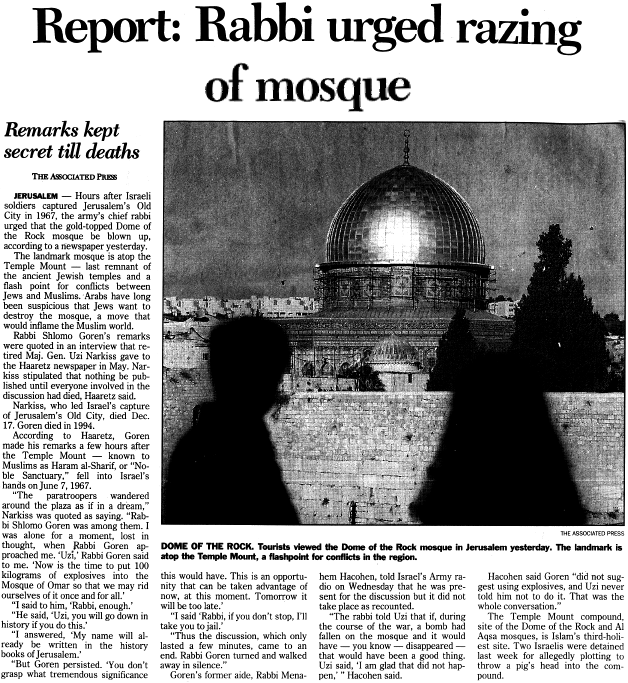
ISRAEL AT THE MERCY OF THE RELIGIOUS PARTIES
by Joseph Algazy
National Religious Party (Mafdal or NRP), Orthodox Zionist orientation, with a moderate wing both political and religious. Since the war of June 1967, the party has taken a hard nationalist line. Supporting Eretz Israel (that is, Jewish settlement and the annexation of the occupied territories), it acted as a cradle for Gush Emunim. This movement of extremist settlers sees itself as the heir to Rabbi Yehuda Kok who was the first TO COMBINE MESSIANIC JUDAISM WITH NATIONALISM. His young supporters go to special religious schools (yeshivot hesder) where they learn the holy scriptures together with arms drill (unlike the normal yeshivot whose graduates do not usually join the army). The NRP voted against the Oslo accords and aims for their annulment. At the elections of 29 May 1996, the NRP won just over 240,000 votes and nine Members of Knesset (MK).
The Yahadut Hatora bloc consists of two movements of Ashkenazi origin, Agudat Israel and Degel Hatora. The former is an ultra-Orthodox, non-Zionist party, which in the past held moderate political positions, and then from the 1980s opportunistically followed the hard line of the pro-annexation right. Its leadership could return towards the Labour Party if it were to gain power and material advantage from such a shift. Degel Hatora came into being in the 1980s as the result of a split within Agudat Israel to do with dynastic rabbinical rivalries. In these two parties, their rabbinical mentors take the decisions. In the 1996 elections, the Yahadut Hatora bloc won almost 99,000 votes and four MKs.
Shas brings together Oriental (mainly Moroccan) ultra-Orthodox Jews, who felt discriminated against in Agudat Israel. They split from it in 1984 and managed in a few years to overtake it in terms of supporters and voters. Shas' main political leader is Arieh Deri, a born manipulator, and its spiritual guide id Rabbi Ovadia Yossef, a former Sepharadi Chief Rabbi. Shas' leaders, like those of Agudat Israel, know how to play on the rivalry between the two main parties to draw maximum profit. At one moment, they supported Yitzhak Rabin and the Oslo accords. Still verbally supporting the peace negotiations, they help Binyamin Netanyahu stay in power. Shas recruits essentially among poor Orientals, exploiting social discontent and "ethnic" resentment of the Ashkenazis. But it also engages in superstition, giving out amulets and saying that their spiritual leader, Eliyahu Kaduri, has supernatural qualities. The party has reservations about settlements in the occupied territories, except in East Jerusalem. In the last elections, Shas won nearly 260,000 votes and got 10 MKs.
Other extreme right-wing parties, not in themselves religious, attract large numbers of religious supporters and voters. This is the case of Moledet (Motherland) which calls for "transfer" - that is, expulsion - of the Palestinians. The same goes for the supporters of Kach, supposedly banned, which, like the Neemanei Har Habayit (Faithful of the Temple), use religion to justify their ideology and fascist-leaning practices. They create provocations, especially in Jerusalem, with the declared object of pulling down the mosques and rebuilding the Temple.
The project for building the third Temple is well-advanced, according to the well-informed daily Maariv. Plans are supposed to be ready. A quarry is preparing to supply special stones for the building. A groups of gold and silversmiths is taking care of ritual objects. A Hassidic farmer in Louisiana, USA, is rearing a herd of cows for the sacrificial rites. Priests have been initiated into the secrets of the cult (1). According to Al-Sinara, silver plaques are even on sale, with all the mosques replaced by the Great Temple. Mr Netanyahu gave one of these to Archbishop Maximus Salum in Haifa at the Christian new year (2). Nothing strange. Behind those in charge of the erection of the Temple are figures close to the present government" Translated by Wendy Kristianasen
Doomsday in Jerusalem? Christian Messianic Groups and the Rebuilding of the Temple
by Yaakov Ariel
The rebuilding of the Temple has played an important part in Christian pre-millenialist Messianic expectations. Such an event would for them signify the imminent arrival of the messianic age. Following the Six-Day War in 1967 and the Israeli conquest of the historical parts of Jerusalem, many pre-millenialist Christians have expected the Jews to build the Temple and reinstate the sacrifices prescribed in the Bible. The rise in the 1970s of Jewish groups that have advocated, and at times made preparations for, the rebuilding of the Temple has encouraged Christian pre-millenialists. Evangelical leaders and organizations, which represent millions of conservative Christians, have lent their support to the state of Israel as the nation that prepares the ground for the arrival of the Messiah. Some Christian pre-millenialists have taken steps to help hasten the rebuilding of the Temple and consequently the coming of the Messiah. They have helped finance Jewish groups that have called for the rebuilding of the Temple. They have also searched for the Lost Ark, helped breed red heifers whose ashes are needed in order to enable Jews to enter the Temple Mount, and researched the exact location of the Temple. In rare isolated cases, extremists have tried to burn or blow up the mosques on the Temple Mount in order to secure the ground for the building of the temple. Towards the year 2000, Israeli and American officials became particularly concerned that Christian believers in the imminent arrival of Jesus would try to hasten the messianic clock by helping Jewish extremists blow up the Temple Mount mosques. The prospect of a successful Jewish-Christian collaboration in such a scheme could let all hell loose and bring about a Middle Eastern apocalypse.
Challenge to Believers
from the Nations
How Can You Help?
Vision of Redemption
Policy StatementVisit Israel! November 1 - 13, 2003....Come and join us for the first Project Shofar mission to Israel. G-d is regathering His people and building up the land of Israel. The time of redemption is near and we can and must encourage G-d's people Israel to believe and trust only Him. The nations will be drawn into the valley of decision for the day of the L-rd is near (Joel 3.14). Let us open our spiritual eyes and see the Glory of G-d in Israel today. — Jon Klein
The goal of the Temple Mount Faithful is the building of the Third Temple on the Temple Mount in Jerusalem in our lifetime in accordance with the Word of G-d and all the Hebrew prophets and the liberation of the Temple Mount from Arab (Islamic) occupation so that it may be consecrated to the Name of G-d. (This, of course, implies the destruction of Harem-esh-Sharif).
Thanks to the intensive and constant campaign of The Temple Mount and Land of Israel Faithful Movement over the last three years, the government of Israel today [20 August 2003] reopened the Temple Mount to Israelis, Jews, Christians, and non-Moslems. It was so important to hear from the Israeli Minister of Internal Security that the Temple Mount will never again be closed to Israelis, Jews, Christians, and non-Moslems. more ...
• Terror Against Children, Babies and Families in Jerusalem...Yesterday evening (19 August 2003) at 9:20 PM, an Arab suicide murderer, dressed as an ultra-orthodox Jew, boarded a bus and detonated a very large bomb. Twenty were murdered and 118 injured. To all the world we say today that you cannot stand by passively today in front of the shedding of the innocent blood of babies and children and their parents in the midst of the holy Jerusalem. More ...
The Temple Mount and Land of Israel Faithful Movement
P.O. Box 18325, Yohanan Harkanos #4, Jerusalem, Israel.The Temple Mount: Truly Ours?
July 18, 2002(This editorial appeared in the Jerusalem Post on Thursday, July 18, 2002)
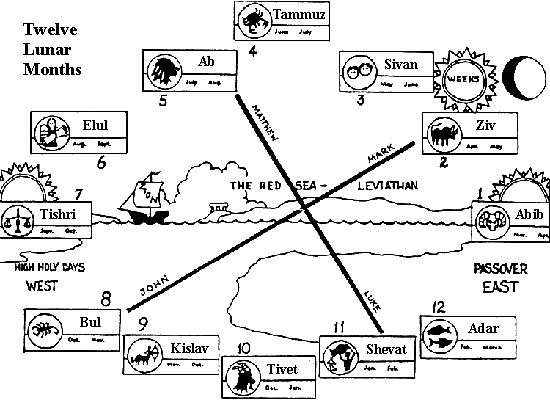
Tisha B'Av, it is not in the East.
Today is Tisha B'Av, the ninth day of the Hebrew month of Av, the saddest day on the Jewish calendar. It marks the destruction of the First and Second Temples in Jerusalem, the ancient demise of Jewish sovereignty and the dispersion of the people of Israel to the four corners of the earth. Throughout Jewish history the date has come to be associated with a range of national disasters, from medieval expulsions and persecutions to the outbreak of World War I. Accordingly, it is a day steeped in sorrow, one tradition says is to be spent in fasting and remembrance.
For Israelis, the need for a national day of mourning has perhaps never been so self-evident. After a lull of nearly three weeks, Tuesday's horrific terror attack in Emmanuel was a lethal and painful reminder that Palestinian terror is still very much a threat, lying in wait for any opportunity to kill and maim as many innocent Israelis as possible.
The central focus of the Tisha B'Av rituals, of course, concerns the Temple Mount, where King Solomon's temple once stood. Observant Jews pray for its rebuilding daily, and for many Israelis the Mount itself symbolizes the historic return of the Jewish people to their homeland. Indeed, the crowning moment of the Six Day War came when the crackling radio blared the words "Har HaBayit beyadenu!" (The Temple Mount is in our hands!) across the airwaves, signifying the liberation of Judaism's holiest site.
The enthusiasm of the moment, however, was quickly diluted when defense minister Moshe Dayan handed over the keys of the Mount to the Muslim Wakf. Worse still, in the intervening years successive Israeli governments have demonstrated shameful apathy-- often outright indifference-- to the Wakf's actions, doing little to prevent the wanton destruction of priceless historical and archaeological artifacts.
As prominent archeologist Dr. Eilat Mazar, a leader of the Committee Against the Destruction of Temple Mount Artifacts, noted the other day, the situation on the Mount is highly precarious. In an interview with Arutz Sheva, Mazar said, "The large scale destruction of artifacts has stopped and the trucks have stopped carting away tons of valuable debris, but the situation is still bad: There is no supervision whatsoever on the Temple Mount. We have no way of knowing what is going on underground in the large caverns, where the Wakf has been making preparations to build and make major changes."
Even more worrisome, Mazar noted, are the effects of the Wakf's unsupervised work on the structural stability of the site: "The Southern Wall is beginning to buckle because of the changes they are making...and nothing is being done about it. The Sharon government has decided to ignore the matter, despite the critical importance of what is going on there." Last year alone the Wakf was able to remove some 20,000 tons of debris uncovered during its unlawful excavations, which reportedly included artifacts dating back to the First Temple period. To date, charges have yet to be brought against anyone in the Wakf for these brazen acts of defiance. As Mazar put it: "Their stated goal is to turn the entire Temple Mount compound-- all 144 dunams of it-- into an active mosque. They are doing so, and no one is stopping it."
Sadly, the government continues to play into the Wakf's hands by acceding to its refusal to allow non-Muslims to visit the Temple Mount or pray there. Though Israel justifiably prides itself on its policy of freedom of access to the holy sites for members of all faiths, that policy-- inexplicably-- does not seem to apply to Jews on the Temple Mount.
Leaving aside the halachic issues involved, it is simply unfathomable that Israel's government should close off the Jewish people's holiest site and bar entry to Jews, all because of the Wakf's intolerance and bigotry. It is an affront to the rule of law and, as Tisha B'Av reminds us, to Jewish history as well. It is time for the sound of Jewish prayer to return to the Temple Mount. Three decades of inaction have allowed the Wakf to thumb its nose at Israeli rule, calling into question just who is in charge on the Mount.
Interior Security Minister Uzi Landau courageously chose to shut down the offices of Al-Quds University in Jerusalem last week because they were defying Israeli law and sovereignty. One can only hope the government will awaken to the plight of the Temple Mount as well, and act to restore Israel's control over it-- in the fullest sense of the word.
Rabbi Chaim Richman, THE TEMPLE INSTITUTE ...www.templeinstitute.org
Islamic Denial of Temple Mount History
January 28, 2001
By Jerusalem Post Staff and Itim
JERUSALEM (January 28) - Palestinian Authority Mufti Ikrima Sabri on Friday denied a report in that day's The Jerusalem Post that the Supreme Moslem Council had stated in a 1930 pamphlet that the Jews had an undisputable historic connection with the Temple Mount. According to Itim, Sabri said the report was untrue and taken out of context.The Post article quoted an English-language guide for tourists, published in 1930 by the Supreme Moslem Council, which states: "The site['s]... identity with the site of Solomon's Temple is beyond dispute," while a footnote refers the reader to Samuel II:26:25.
Sabri told Itim that the council's booklet had been published only one year after the Arab disturbances of 1929, which, he said, the Arabs called the "Burak Rebellion" (Western Wall Rebellion). Sabri claimed that, at the time, the League of Nations had decided that the Western Wall was Moslem, adding that Jews were permitted to pray there on condition they made no changes to the site; particularly not setting up tables or benches. Blowing the shofar was expressly forbidden.
Sabri also told Itim that the British-appointed Shaw Commission had come to the same conclusion and had decided that the Western Wall was part of Haram al-Sharif [the Temple Mount], and undeniably Moslem property. Sabri told Itim that neither the League of Nations nor the Shaw Commission had mentioned the word Kotel in reference to the Western Wall, only the Arabic al-Burak. The site, he reportedly said, was one of the holiest in Islam, since it was from there that the Prophet Mohammed rose up to heaven.
Sabri added that all these developments had come about when the Supreme Moslem Council was headed by Hajj Amin al-Husseini and that it was inconceivable that Husseini had given Jews any rights at all to the Temple Mount. Itim noted that the Arab Revolt had broken out on August 16, 1929, following an impromptu Arab demonstration organized in response to a Jewish march to the Western Wall on the previous day, Tisha Be'av. The demonstrators were also protesting the expansion of the Jewish Agency. During the protest, Jewish religious objects were destroyed near the Wall.
A few days later, gangs of armed Arabs attacked Jews in Jerusalem, Hebron, Safed, and farming settlements, killing 133 Jews and wounding 339. The Shaw Commission, headed by Sir Walter Shaw, was appointed by the British Colonial Office to investigate the riots, and it concluded that the riots had resulted from Arab fears for their political and economic rights in the face of the development of Palestine as a Jewish national home.
The commission gave the Arab leaders a slap on the wrist, and skipped over the British authorities' responsibility for the events. The League of Nations' Mandate Commission later sharply criticized the Shaw Commission.
THE HOLY WAR THAT ISRAEL WANTS
By Jonathan Cook
The Electronic Intifada
7-12-3The inhabitants of Nazareth, Israel's only Arab city, often talk of the "invisible occupation": although they rarely see police -- let alone soldiers -- on their streets, they are held in a vise-like grip of Israeli control just as much as their ethnic kin in neighbouring Palestinian cities like Jenin and Nablus are. In September 2000, for example, when Israel's one million Palestinian citizens, including Nazarenes, demonstrated against Ariel Sharon's visit to the mosque compound in Jersualem -- known to Muslims as Haram al-Sharif and to Jews as the Temple Mount -- 13 of their number were shot dead by police in four days. Not a single protester had been armed.
Last week the veil was again briefly lifted from the occupation inside Israel. More than 500 heavily armed police officers stormed Nazareth's city centre at dawn, arresting a handful of Muslim clerics and demolishing the foundations of a mosque that has been making headlines since a "holy tent" was first erected in 1998 at the site of the grave of Shihab ad-Deen, the nephew of Salah ad-Deen. In all the excitement over Israel's withdrawals from Gaza and Bethlehem, the invasion of Nazareth was overlooked, except in the Hebrew press, where it was presented as a brave attempt by the government to rein in lawlessness and calm religious tensions in a city that is now 70 per cent Muslim and 30 per cent Christian.
But the case of Nazareth's "rogue" mosque is far more complicated than this -- and potentially more revealing of the political games Israel is playing with the delicate balance of forces between the country's religious communities.
In fact, far from being patently illegal, the mosque had actually won approval from two governments, Binyamin Netanyahu's in 1998 and Ehud Barak's in 1999. Both backed the plan, even though the mosque was to be located a few provocative yards from one of the holiest churches in the Middle East, the Basilica of the Annunciation. (Built on the site, say Catholics, where the Virgin Mary was told she was carrying the son of God.) Violent clashes briefly erupted between Christians and Muslims in the wake of these decisions.The government's position, however, changed last year, apparently after the Pope and President George W. Bush got wind that local Muslims had started laying the mosque's foundations. Bush put heavy pressure on Sharon to intervene, and dutifully the Israeli prime minister set up a committee to consider the question again. It used a loophole -- that the building work had begun before all the official papers had been received -- to justify finding against the mosque's completion in March 2002. There has been plenty of unhelpful hyperbole from Muslim clerics about the mosque destruction being a "war on Islam," but one point they make is worth examining. Why, in the same week as the demolition, they ask, did Israel reveal it was allowing Jews to return to Jerusalem's Haram/Temple Mount complex? Non-Muslims have been banned from the area since Sharon's visit 33 months ago unleashed the intifada (as de facto have most Palestinians, who can longer get permits to enter Jerusalem). For a government so zealously concerned about sectarian provocations, this was a strange decision.
In fact, Jews demanding to go to the mount are mainly Messianic extremists who want to destroy the al-Aqsa and Dome of the Rock mosques and replace them with a reconstruction of the Second Temple. Mainstream Jews have been prohibited from the site since rabbis banned prayer there in the Middle Ages. But that has not stopped the government from promoting Jewish claims to the mount. In May the public security minister Tzachi Hanegbi became the latest cabinet minister to say it was time to let Jews pray there.
The Israeli government's behaviour in Nazareth is equally baffling. Despite newspaper claims, the city's Christians and Muslims forgot their differences a while ago, with the outbreak of the intifada and the more pressing concern of how to survive the economic slump. The decision to demolish the mosque in such a heavy-handed manner is far more likely to tear the delicate fabric of civic life here. Already there are calls for the resignation of Nazareth's Christian mayor, Ramez Jeraisi. So why do it now? Nazareth's Christians and Muslims unite in offering a disturbing explanation. They say Israel has a vested interest in fomenting trouble in their city to show that the two religions cannot live together in peace. "If they cannot share their holy sites in Nazareth, how can they ever do so in Jerusalem?" is how Nazarenes describe the logic of Israeli spin.
At the end of the long path of the US-backed road map to a Palestinian state is an international conference to decide the most charged question of all: who should have sovereignty over Jerusalem and its holy places, the Israelis or the Palestinians? Both peoples hope to be rewarded with control of the Haram al-Sharif/Temple Mount site. In the meantime the struggle for the ultimate prize, including Israeli attempts to weight the decision in its favour, risks doing irreparable damage to religious tolerance in the Holy Land.
Jonathan Cook lives in Nazareth and writes for The Guardian (UK) and Al-Ahram Weekly (Egypt).
©2000-2003 electronicIntifada.net
BORN-AGAIN ZIONISTSCHRISTIAN CONSERVATIVES ARE TEAMING UP WITH HARD-LINE JEWISH GROUPS TO TRANSFORM AMERICAN POLICY TOWARD ISRAEL
by Ken Silverstein & Michael Scherer
September/October 2002__Nearly three decades after leaving his job as a marketing manager at Colgate-Palmolive, Ed McAteer, considered one of the godfathers of the modern Religious Right, still sounds like a salesman. In a well-honed patter, he tells of introducing Jerry Falwell to then-presidential candidate Ronald Reagan, discussing spiritual matters with Jesse Helms and John Ashcroft, and helping organize the evangelical movement that has become the most powerful grassroots component of the Republican Party. But no subject excites the 76-year-old born-again Baptist more than his unequivocal love for the Jewish people and the state of Israel, and his increasingly influential role as one of the nation's leading "Christian Zionists."
The passion of McAteer, a gregarious man with a toothy smile and thinning wisps of brushed-back hair, is evident during a prayer breakfast in May for more than 200 people at the Israeli Embassy in Washington, D.C. "I am delighted and thrilled and just pumped up to be here," McAteer tells the crowd in a Tennessee drawl, nearly bouncing behind a podium backed by brightly colored banners celebrating the biblical tribes of Israel. Before him sits the self-described inner circle of Christian Zionism: pastors, preachers, and religious activists who quietly but effectively lobby for Israel. With a born-again Christian in the White House and events in the Middle East spinning out of control, McAteer recognizes the power of those in the room to influence U.S. policy on behalf of Israel. "The best friends that Israel has are those people who believe the Bible does not contain the word of God, but that the Bible is the word of God," he announces to the faithful.
When McAteer left the business world in 1976 to help organize the Christian right, the idea of the Israeli government working hand in hand with conservative Christians would have been difficult to imagine. At that time, some evangelical groups were openly anti-Semitic and associated with the John Birch Society and other far-right groups. Today, though, Christian conservatives provide Israel -- and in particular the hard-line Likud Party of Prime Minister Ariel Sharon -- with its most important political support in the United States. They oppose Israel ceding land to the Palestinians and are pressuring the Bush administration to close Palestinian offices in the United States. They also have close ties to GOP congressional leaders and to a group of high-ranking hawks in the Pentagon -- led by Deputy Defense Secretary Paul Wolfowitz -- that some D.C. insiders call the "Kosher Nostra."
"They are very vocal and have shifted the center of gravity toward Israel and against concessions," says Doug Bandow, an evangelical who serves as a senior fellow at the conservative Cato Institute. "It colors the environment in which decisions are being made." Indeed, thanks to the top-level connections and grassroots activism of evangelical Christians, U.S. policy in the Middle East has never been so closely aligned with Israel as it is under the administration of George W. Bush. As the conflict in the Mideast has heated up, even some of the Jewish state's most ardent supporters have been surprised by the president's strong pro-Israel stance.
The complete version of Born-Again Zionists can be read in the September/October issue of Mother Jones magazine.
Reviving the Stones
January 2, 2000
© 2000 The Temple Institute, Rabbi Chaim Richman - All Rights ReservedLast week we brought you several reports concerning the unlawful and malicious destruction being waged on the Temple Mount. However it was only recently that I was able to personally visit the site where the Moslem Wakf has dumped hundreds of truckloads of fill taken from the bowels of the Temple Mount, containing building stones and many other remnants from the Temple. I would like to share the unique experience of this visit with you.
One comes upon the massive, man-made mountain at the end of a dirt path in an Arab neighborhood that lies in the shadow of the Temple Mount. In order to educate as many people as possible about this crime, and the part it plays in the overall battle that is being waged against Jerusalem, I was fortunate enough to be able to bring a film crew along, so that these images might be broadcast throughout the world.
A response to some of our previous mailings was received from a man who felt that this story was being overemphasized. He opined that showing such veneration for these stones is tantamount to idol worship. I would like to emphasize that the stones themselves are not even the issue! For as painful as it is to see the remnants of the House of the L-rd treated like rubbish, and to know that it is all part of an effort to erase Jewish history from the annals of Jerusalem...still, WE KNOW THAT ONE DAY THE HOLY TEMPLE WILL BE REBUILT, FROM NEW STONES, AND IT WILL NOT BE DESTROYED. "...
Now therefore ye are no more strangers and foreigners, but fellow citizens with the saints, and of the household of God.
And are built upon the Foundation of the apostles and prophets, Jesus Christ (the mystery of Hesus-Crishna) himself being the Chief Corner Stone...
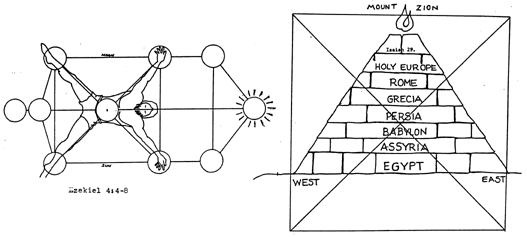
In whom all the building, fitly framed together groweth unto a Holy Temple in the Lord.
In whom ye are also builded together for an Habitation of God through the Spirit...(Ephesians 2:13-22).
Ye also, as lively stones, are built up a spiritual house, to offer up spiritual sacrifices, acceptable to God by Christ Hesus.
Wherefore it is contained in the Scripture, Behold, I lay in Zion a Chief Corner Stone, elect, precious, and he that believeth on him shall not be confounded...(1 Peter 2:5-8; Isaiah 28:16,17).
And in these days, the God of heaven shall set up a kingdom, which shall never be destroyed, and the kingdom shall not be left to other people, but it shall break in pieces and consume all these kingdoms, and it shall stand forever...(Daniel 2:44).
(continued)...The glory of the last house will be greater than that of the former, and in this place I shall grant peace," G-d tells us through the prophet Hagai. The disrespect shown to the antiquities, sacred as they are, is not what bothers those who are sensitive to the honor of G-d. Rather, it is the ultimate sacrilege of the desecration of G-d's own honor, evoking practically no formal response anywhere in the world (including in Israel), that is so intolerable.
It is difficult to verbalize the many feelings that arise when one stands amidst this pile of rubble. I imagine that to some small extent, it is a feeling not unlike witnessing the destruction of the Holy Temple all over again...but of course, the circumstances this time are vastly different. "How the mighty have fallen!" These stones bore witness to the "TEN MIRACLES WHICH TOOK PLACE CONSTANTLY IN THE HOLY TEMPLE." THEY WERE PRESENT WHEN THE ENTIRE NATION OF ISRAEL MADE THE PILGRIMAGE TO THE HOLY TEMPLE DURING EACH OF THE SACRED FESTIVALS OF THE L-RD: "THREE TIMES A YEAR SHALL YOU BE SEEN THERE BY G-D." Within this pile of stones beats the pulse of the collective experience of the Jewish people.
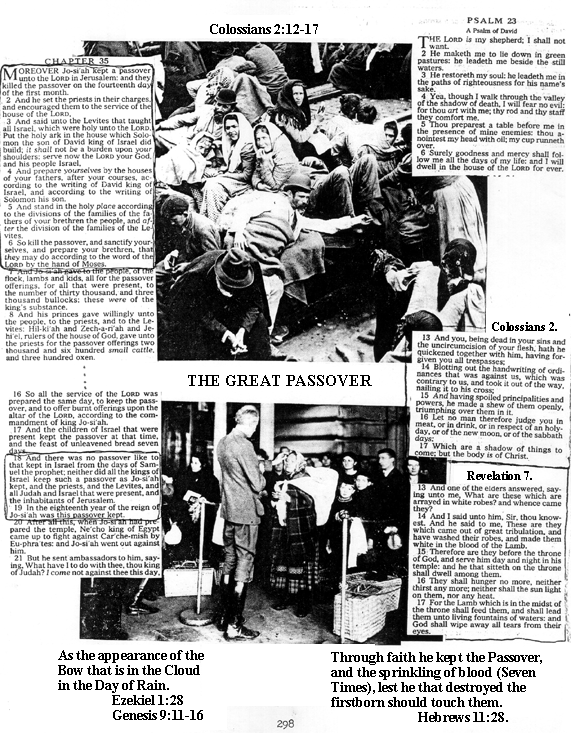
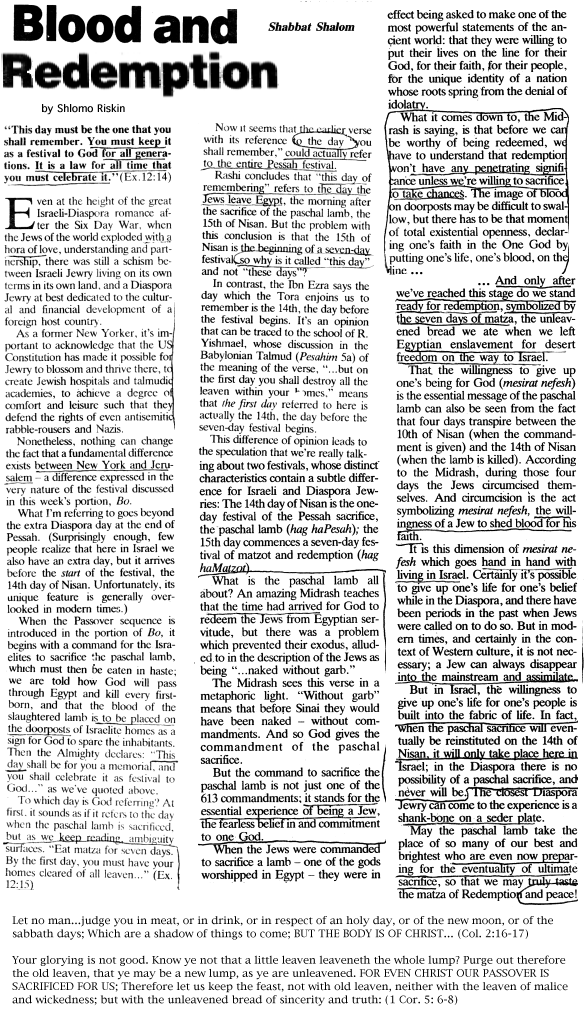
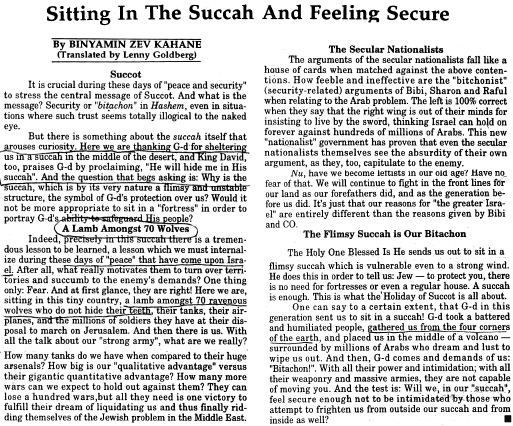
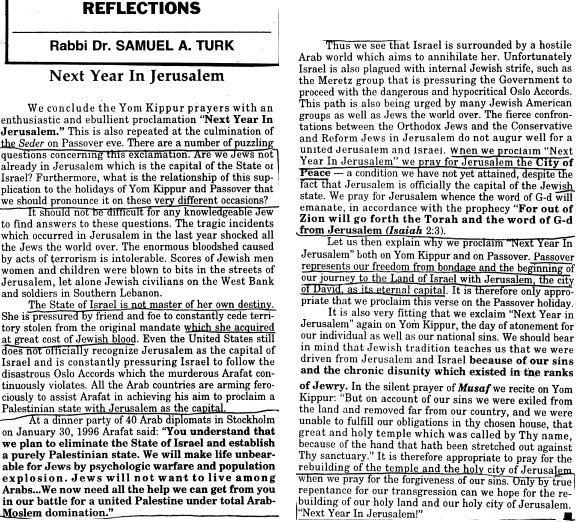
“For Your servants hold her stones dear, and cherish her very dust…” (Psalms 102:15)
Rabbi Chaim Richman

Zion and Meru, the same Movable Mountain.
Standing at the Mountain
June 6, 2000
© 2000 The Temple Institute, Rabbi Chaim Richman - All Rights Reserved
A Message for Shavuot from the Temple Institute
The Biblical festival of Shavuot, the Feast of Weeks, begins Thursday evening. This holiday marks the anniversary of G-d's revelation at Mount Sinai. At this event, which changed the course of human history, the Creator bequeathed the Torah and its commandments to Israel. Israel entered into a covenant with G-d and received her unique, Divine mission: to sanctify the name of G-d before the eyes of the entire world. This goal is exemplified by the commandment of "And you shall make for Me a sanctuary, that I shall dwell among you" (Ex. 25:8), which was actualized in the Tabernacle and later in the First and Second Temples. For when the people of Israel dwell in the Land of Israel according to the Torah of Israel, with the Shechina (the Divine Presence) in their midst, it is the greatest possible sanctification of G-d.
Exactly seven weeks prior to Shavuot, on the festival of Passover, Israel became a nation. The reality of the exodus, on the backdrop of the miracles that attest to G-d's preeminent love for Israel, saw Israel gain her physical freedom and national identity...as the Bible states, "Has G-d ever tried to come to take a nation from out of the midst of another nation, with signs and wonders, and in war, and with a strong hand and an outstretched arm, and with great wonders, like all that the L-rd your G-d has done for you?" (Deut. 4:34)
The period between Passover and Shavuot is known as the "days of counting the Omer" (the omer is a measure of barley that was brought in the Temple on the second day of Passover). This is a period of spiritual cleansing, in anticipation of receiving the Torah at Shavuot -- as the Bible states, "And you shall count for yourselves, from the day following the great Sabbath, from the day you bring the omer wave-offering; seven complete weeks they shall be" (Lev. 23:15). Traditionally, intense spiritual longing and introspection mark this period.
As Passover marks the physical birth of the Jewish people as a nation, so Shavuot represents Israel's spiritual inception. For the covenant that was forged between the Holy One and Israel, is manifest in the Bible…the constitution of the Jewish people. When Israel reaffirms that covenant and accepts that her destiny is unlike that of other nations, then the whole world is elevated through her actions.
One of the focal points of that destiny rests upon the sanctity of the Land of Israel. In fact, in many ways, Shavuot is the special holiday of the Land of Israel. In the time of the Holy Temple, the festival of Shavuot was marked by special Temple observances. Three particular commandments are fulfilled on Shavuot in the Holy Temple, which emphasize the holiness of the Land: the bringing of the omer, the special offering of the twin loaves, AND MOST OF ALL THE BRINGING OF THE FIRSTFRUITS.
Today, while the Temple has not yet been rebuilt, what are our first fruits? What is the status of the Land of Israel, about which the Bible testifies: "It is a land that the L-rd your G-d seeks out constantly; the eyes of the L-rd your G-d are on it, from the beginning of the year to the end of the year?" (Deut. 11:12).
Many in Israel are disheartened. The situation grows more serious from day to day. According to reliable sources, the Barak government's "peace agreement" includes plans to implement drastic measures in the near future, such as: The compulsory transfer of 50,000 Jews from their homes in Judea and Samaria; the transfer of large tracts of the Jordan Valley to the Palestinian Authority; and the complete abandonment of the Temple Mount to the hands of the Palestinians. Our government apparently grows tired of pretending that "the Temple Mount is in our hands…"
A hostile Palestinian state, whose objective is the destruction of Israel and who claims Jerusalem as its capital, is no longer on the horizon. It is at our doorstep, steadily creeping towards the Temple Mount. This bodes ill for all to whom Jerusalem is precious.
Most seem to feel that there is no cause for alarm; after all, they point out, the Jewish people have been through greater difficulties. But on Shavuot night, the prevalent custom is to remain awake the entire night, studying the holy Torah, in preparation for the morning of the Festival, when we receive it anew, like our ancestors did at Mount Sinai. One reason for this custom of not sleeping, is based on the Midrash which teaches that way back on that first morning of Shavuot, the people of Israel overslept at the foot of Mount Sinai. They had to be woken by G-d - and arrived late to the most important event of their lives: the giving of the Torah. Thus every year we remain awake on this night, to rectify that blunder.
This is a message of Shavuot that we must live with, here and now: We have a G-d given constitution, a Divine manifesto...in short, a contract with G-d. That contract is the Torah, which we, the Jewish people, have been entrusted to keep, preserve, and bring to the world. It is in G-d and His Torah that we are to place our trust. But we are now standing at the foot of the mountain, fast asleep. When will we wake up? We dare not oversleep again. Rabbi Chaim Richman THE TEMPLE INSTITUTE JERUSALEM
2 articles from Jewish Voice Today, the magazine of Jewish Voice Ministries International:
(Ezekiel 13)
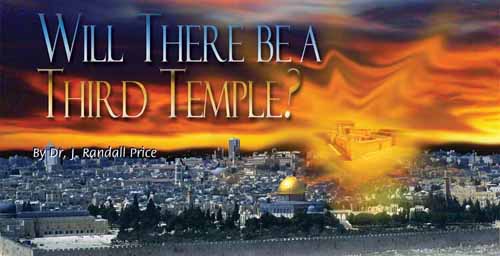
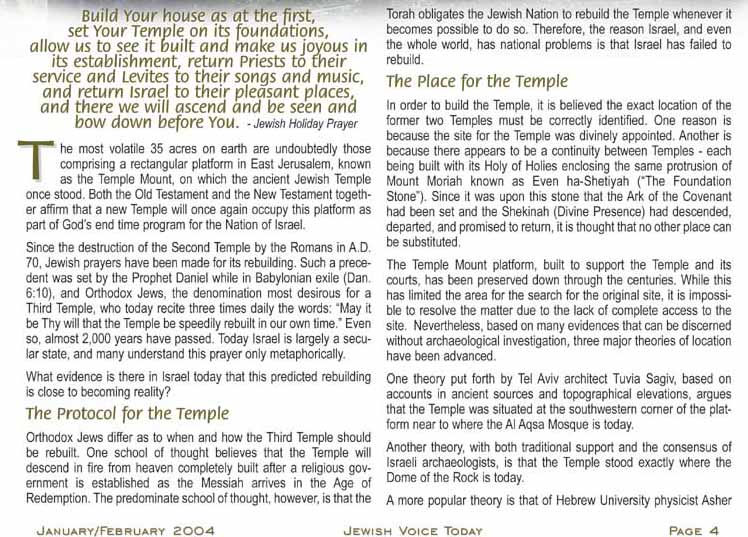
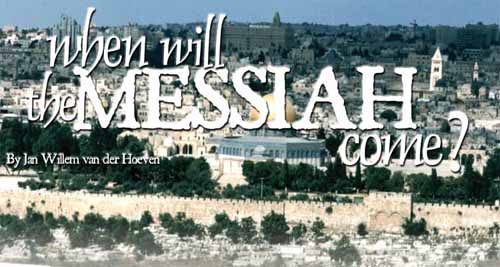
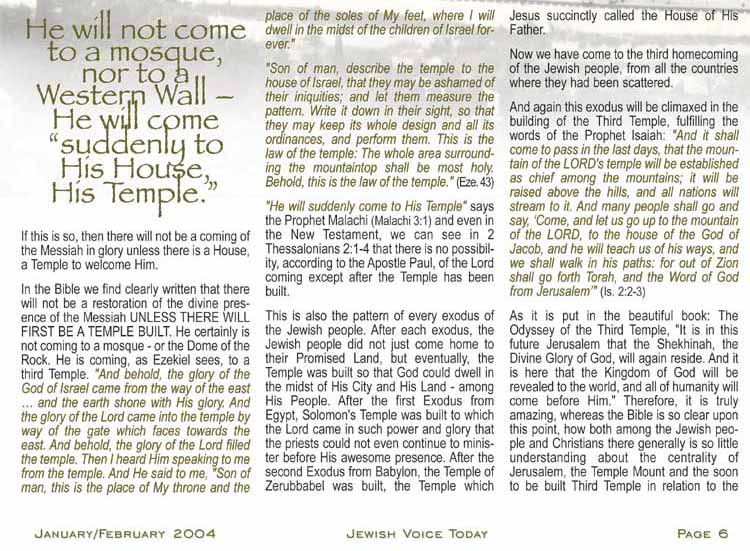
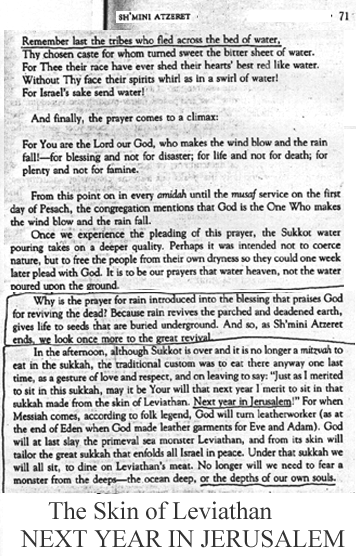
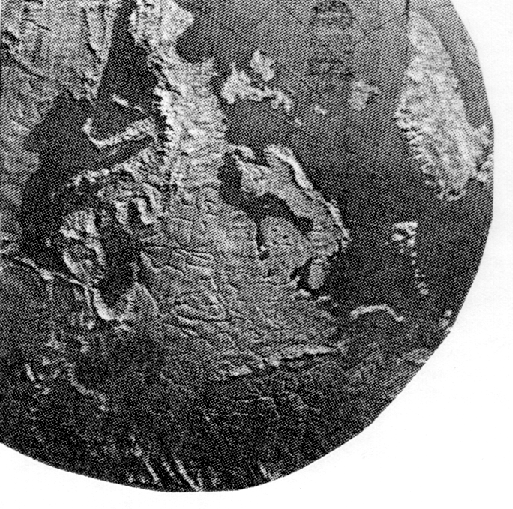
Enough said, enough seen, enough understood...Joel 2:12-32.